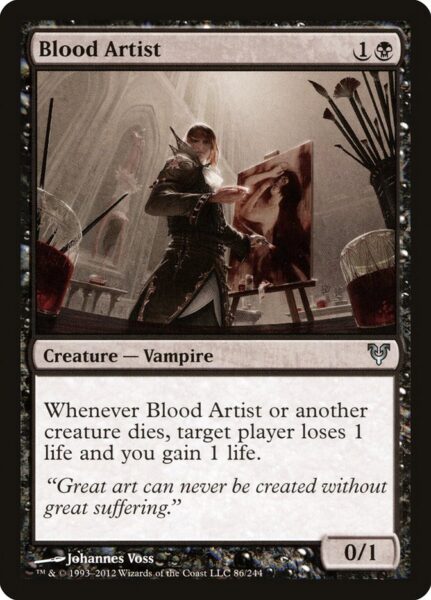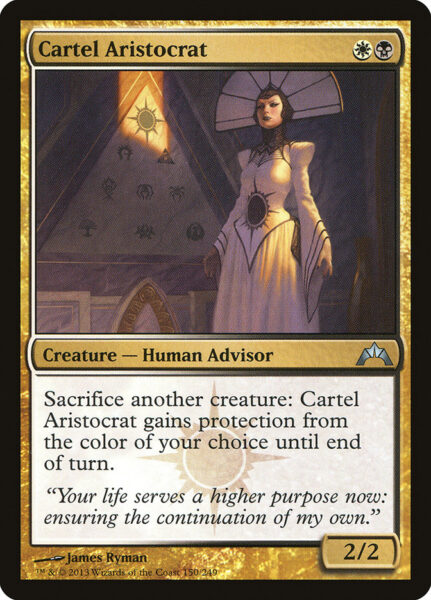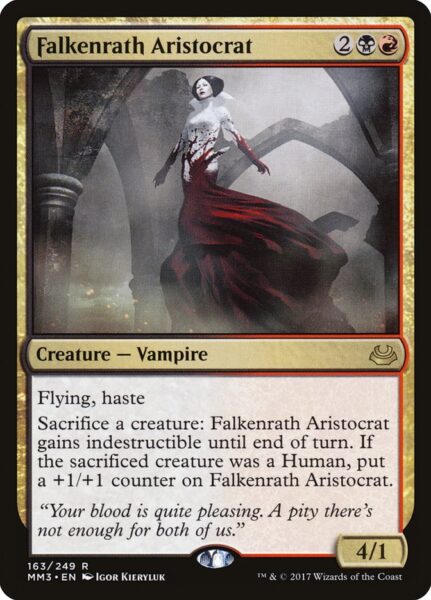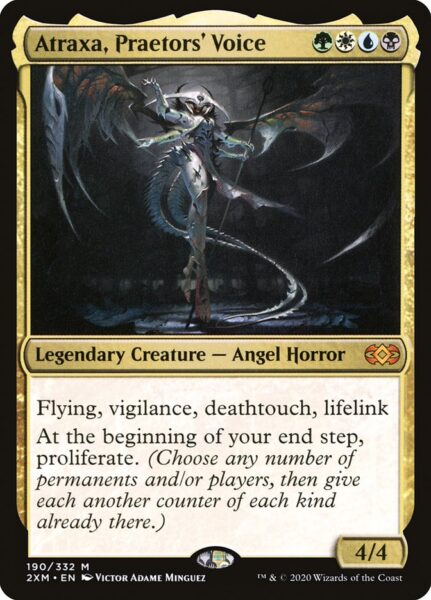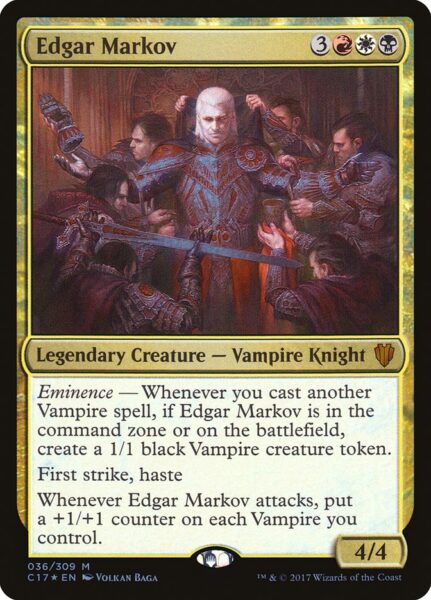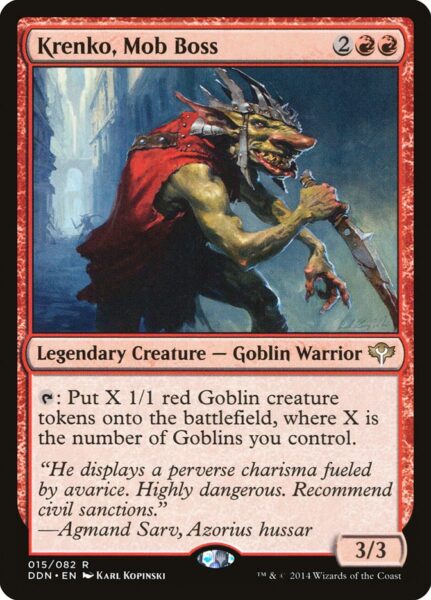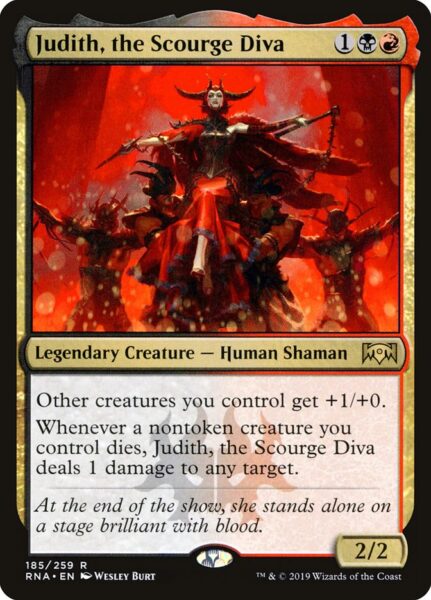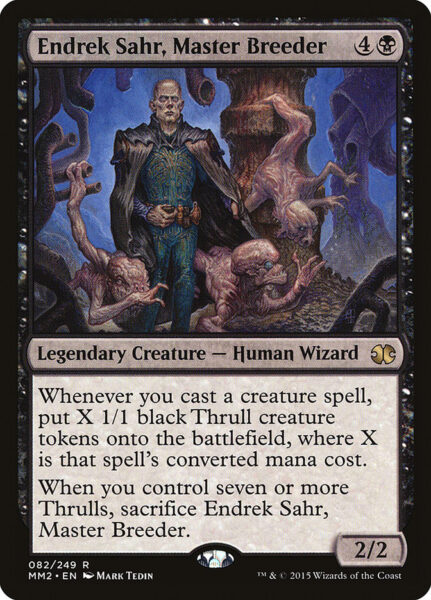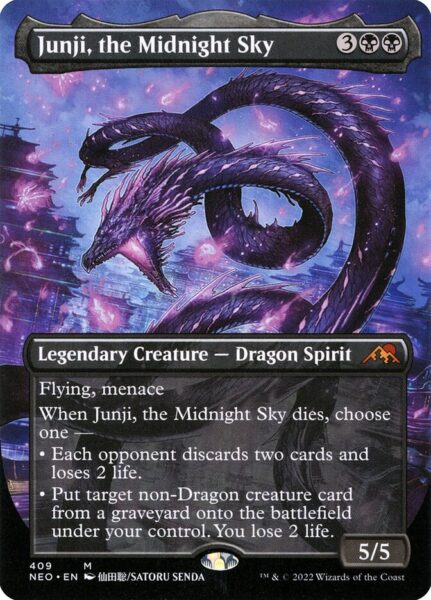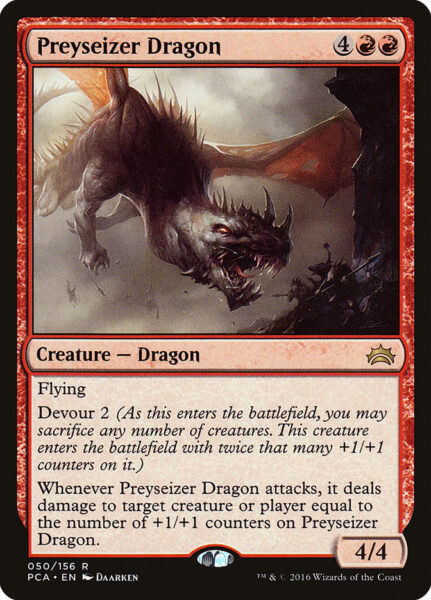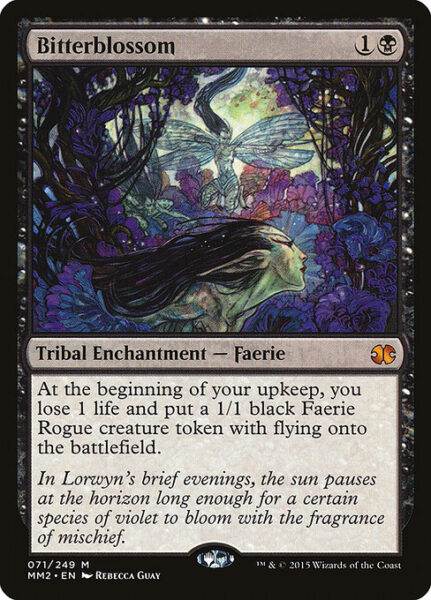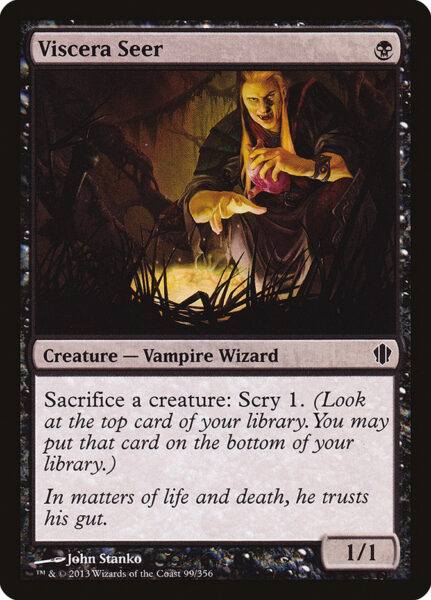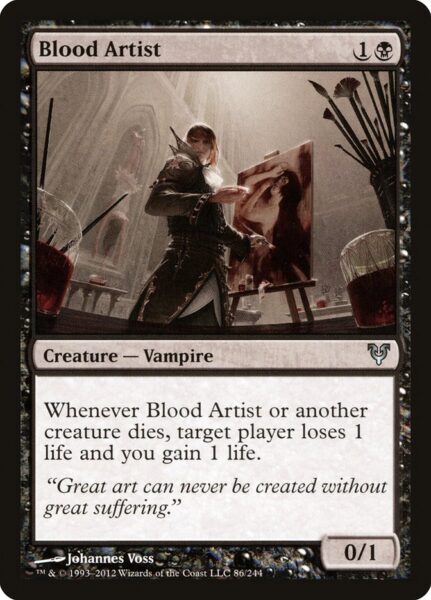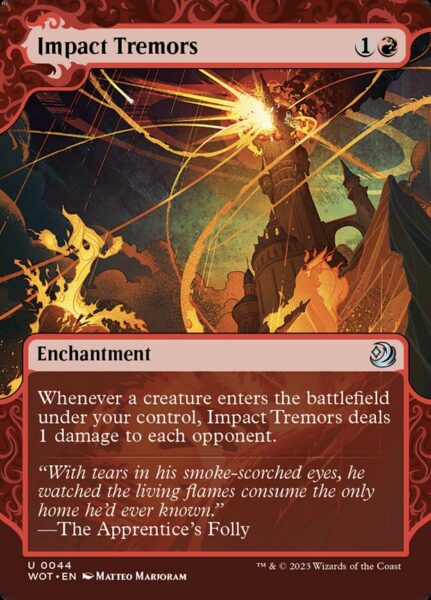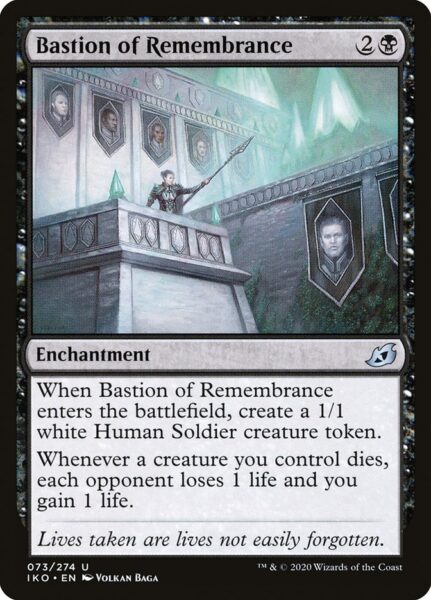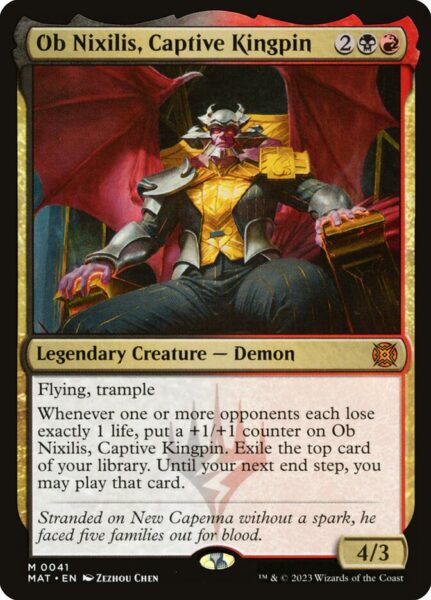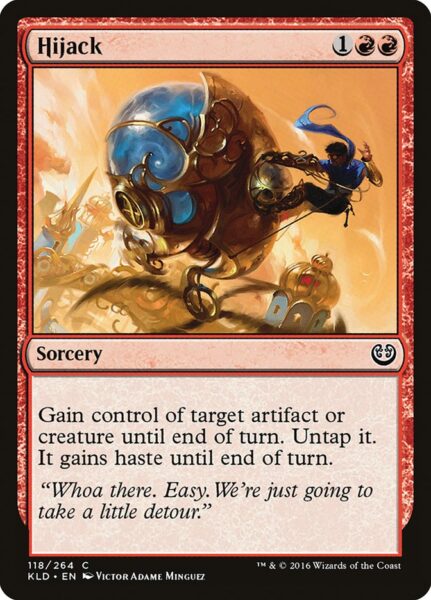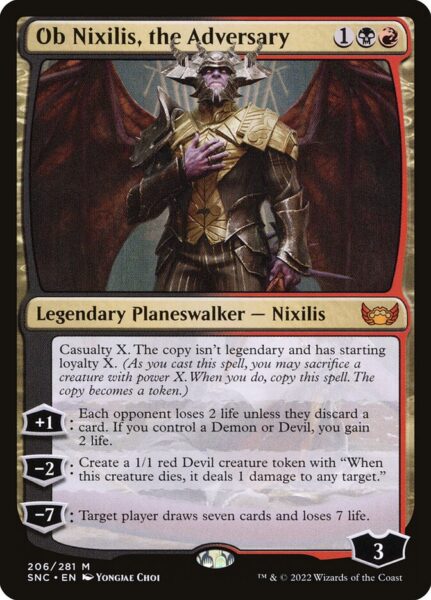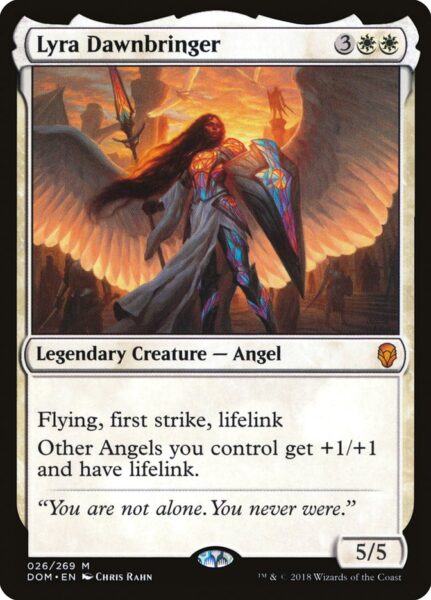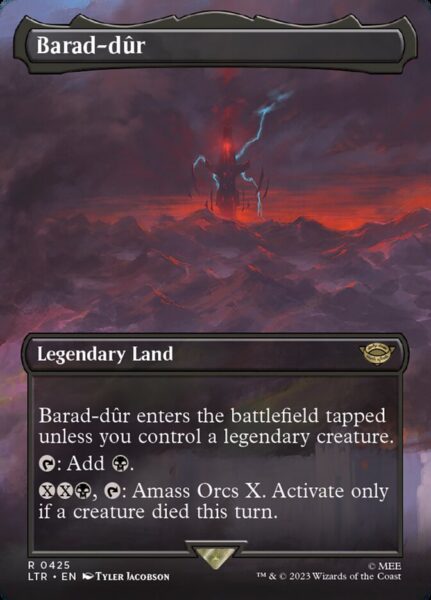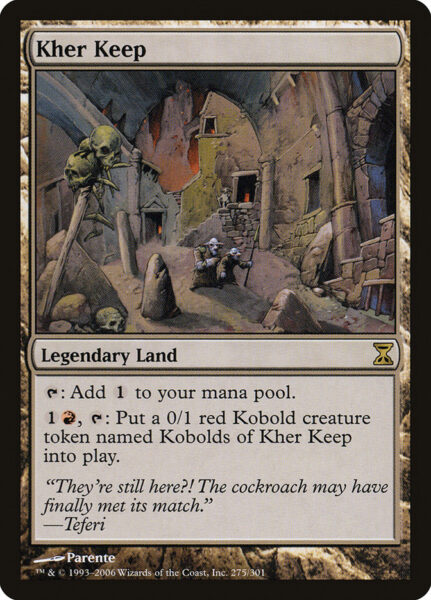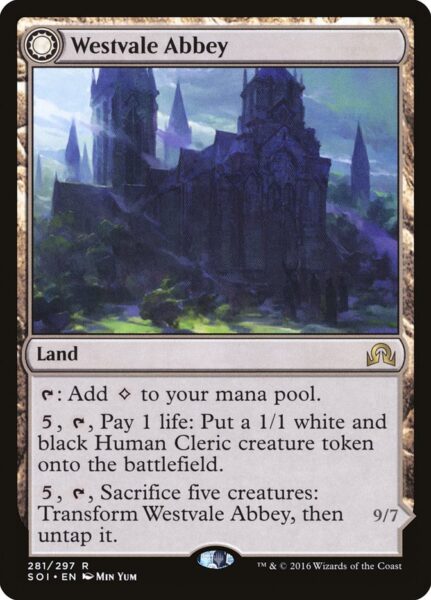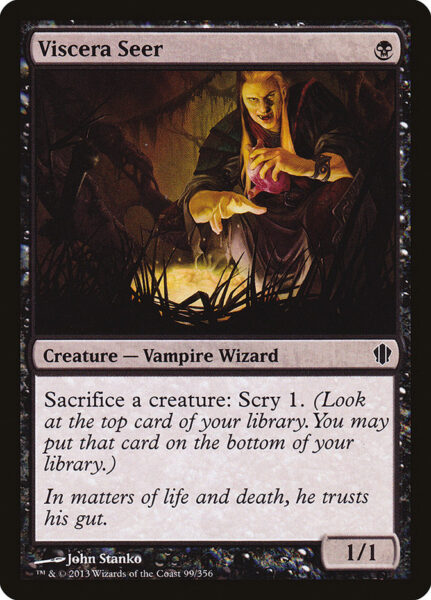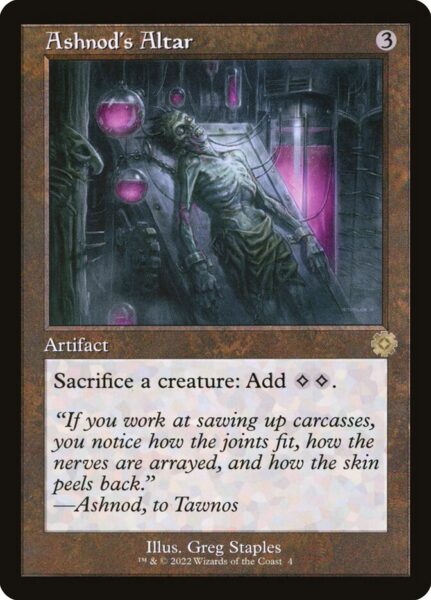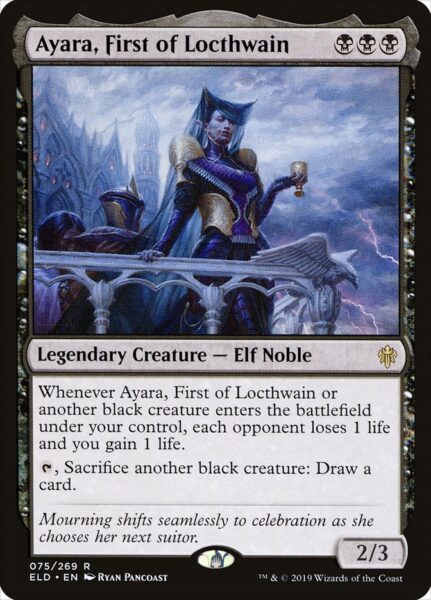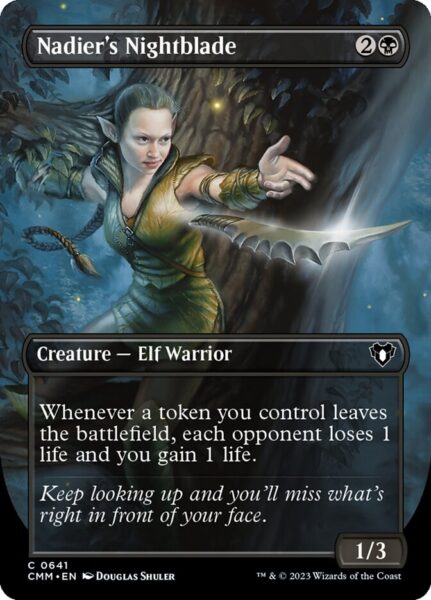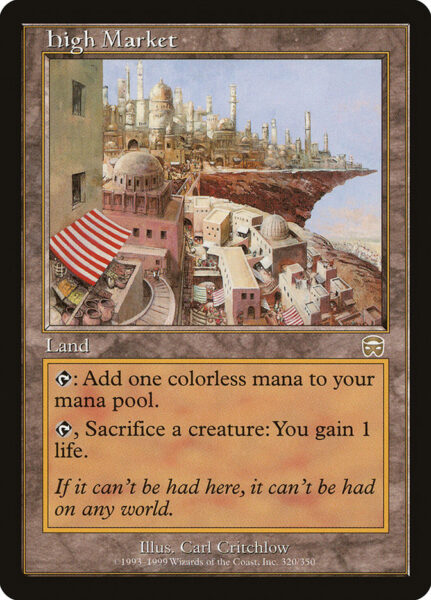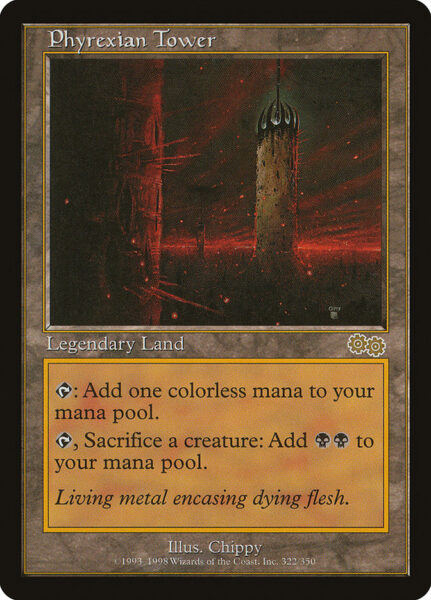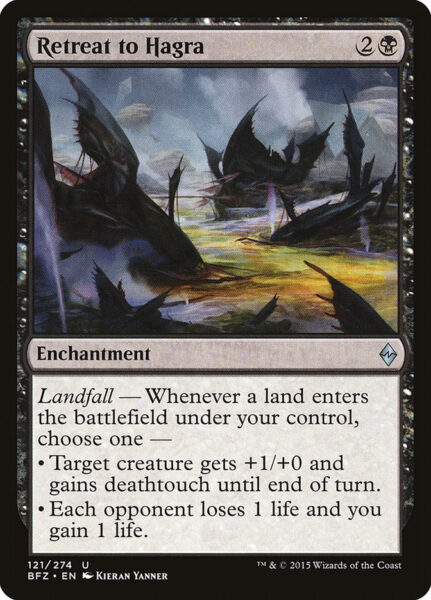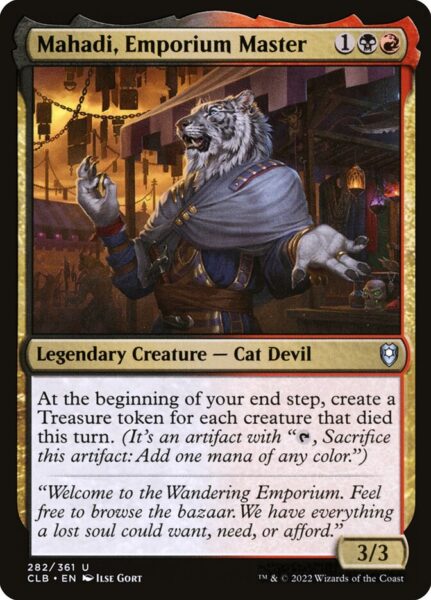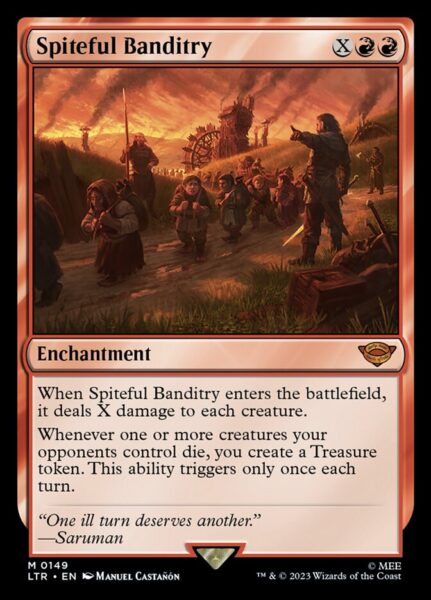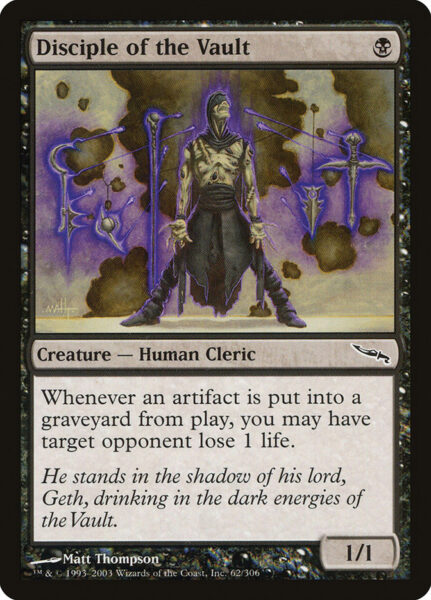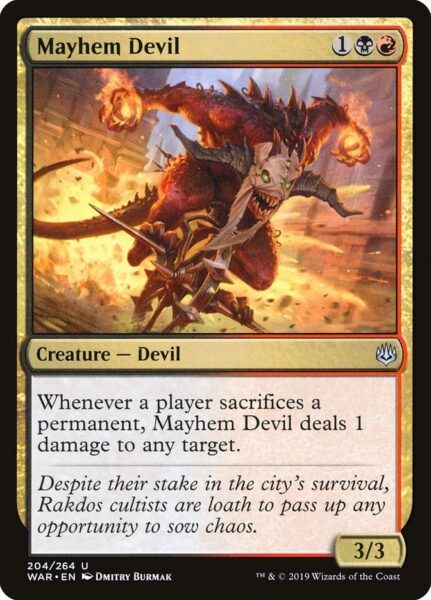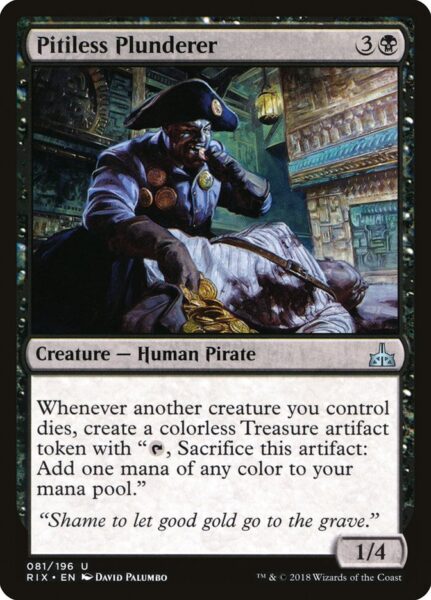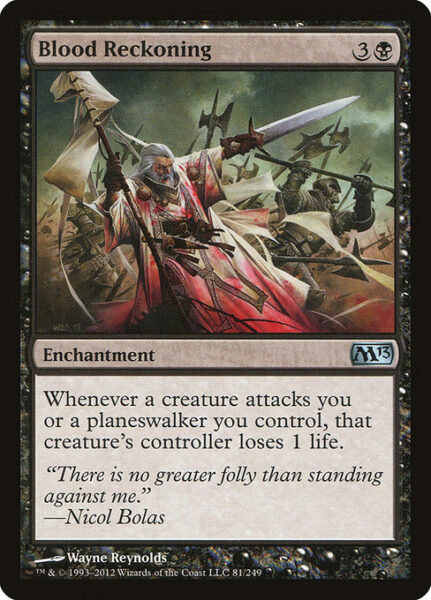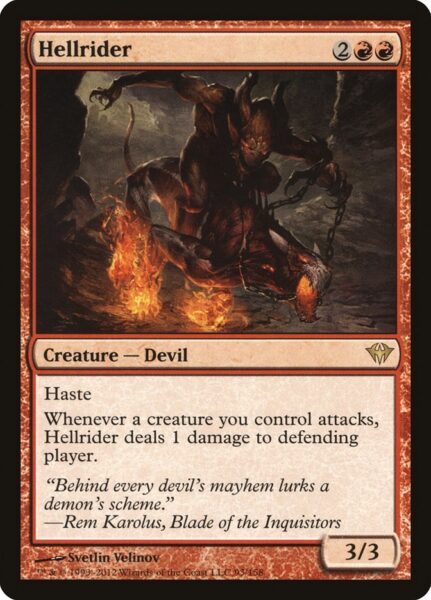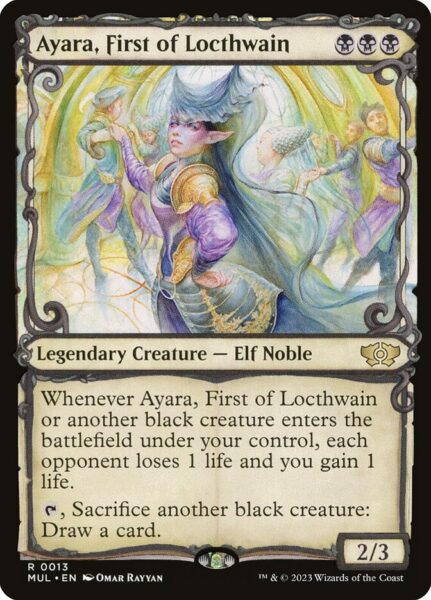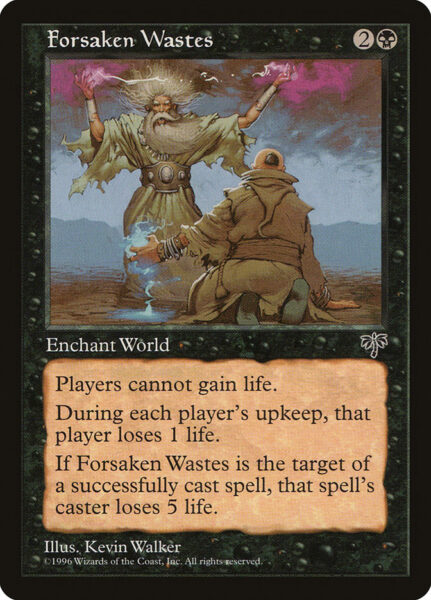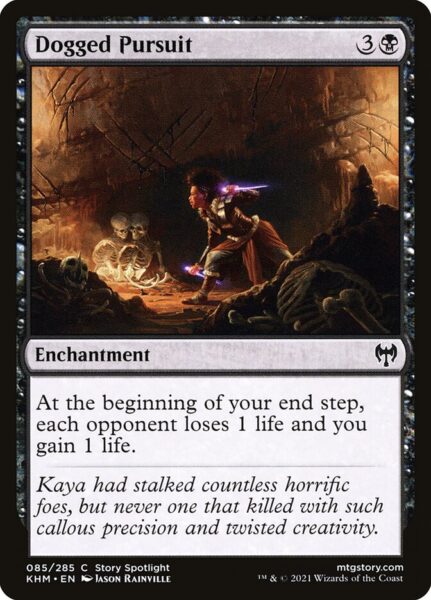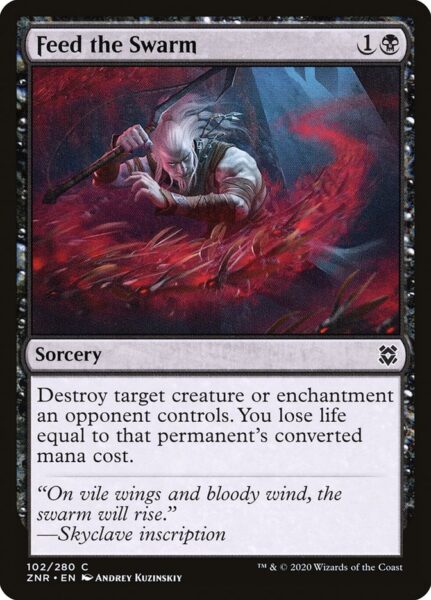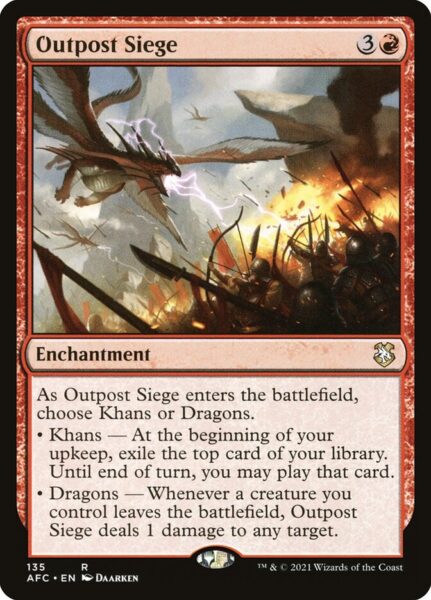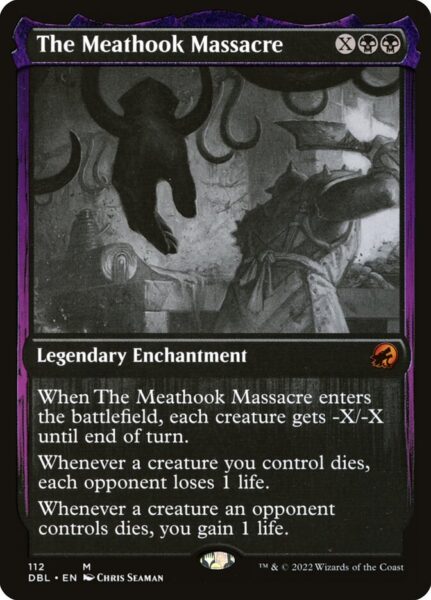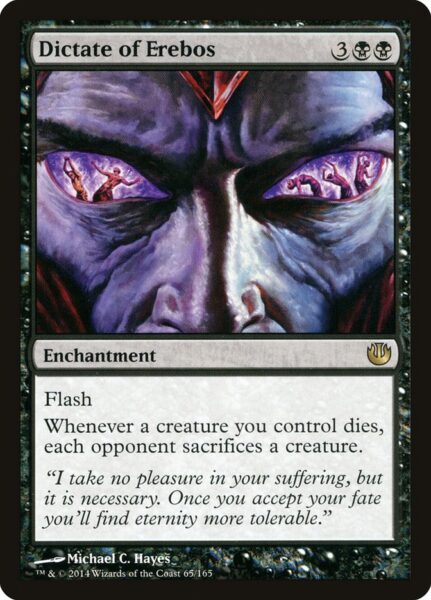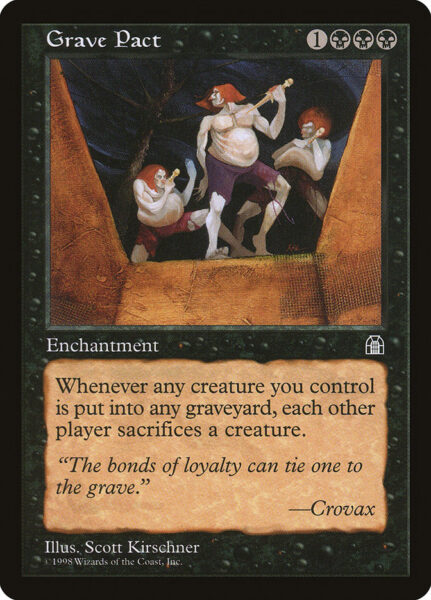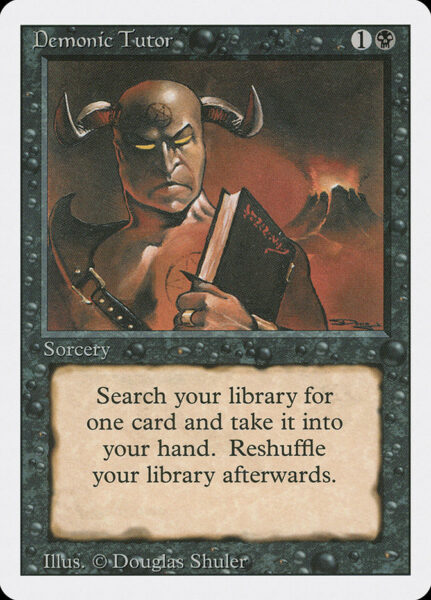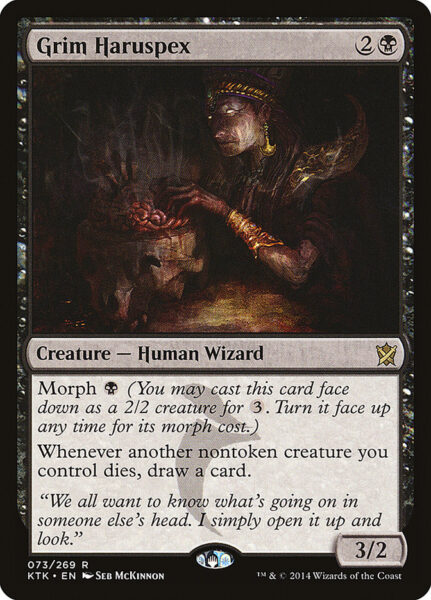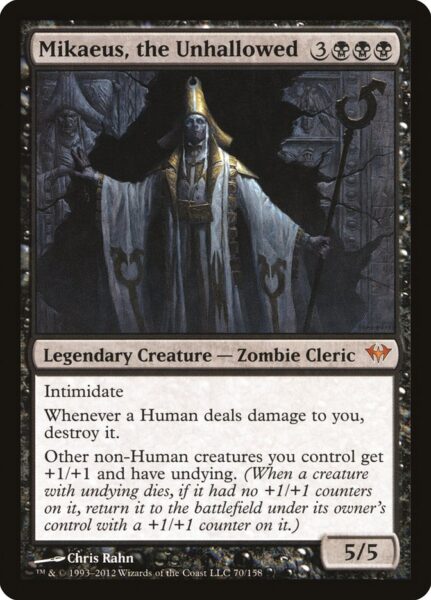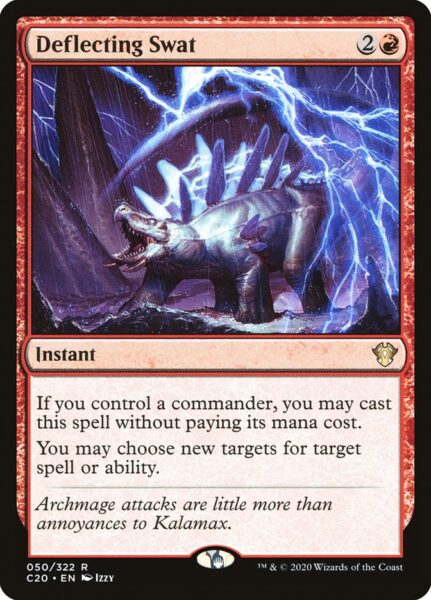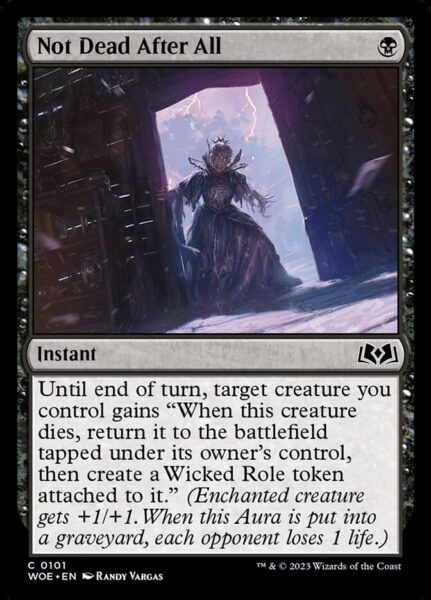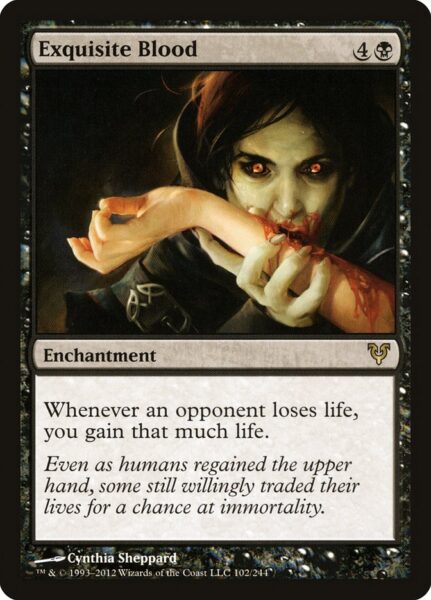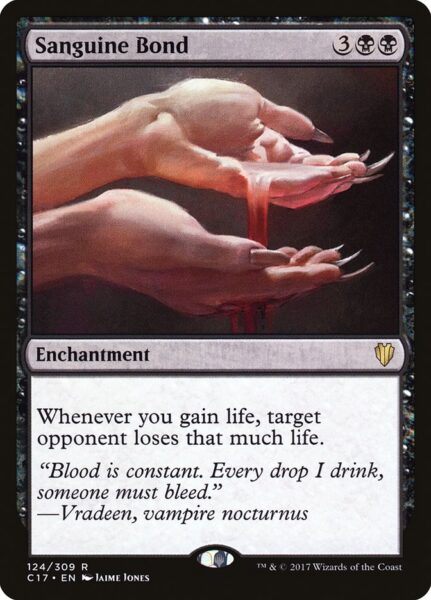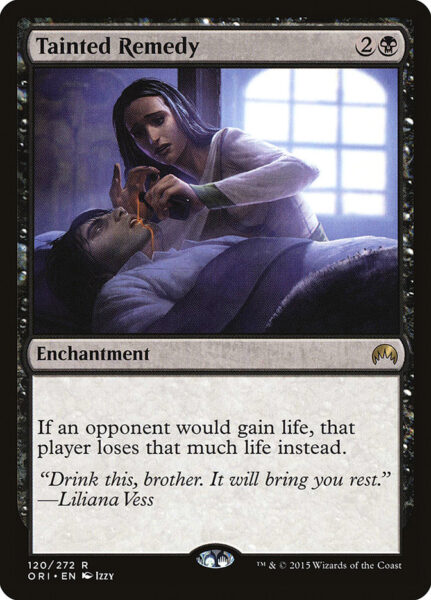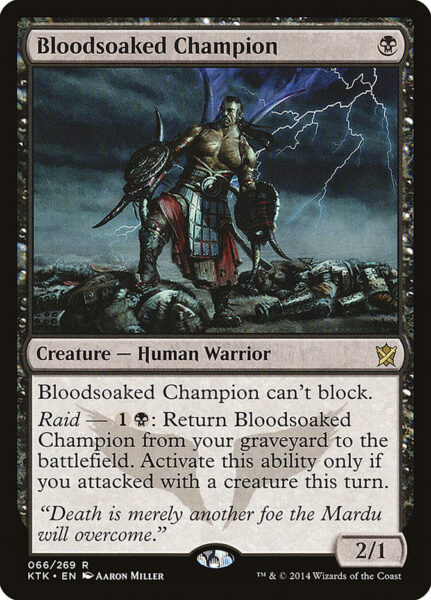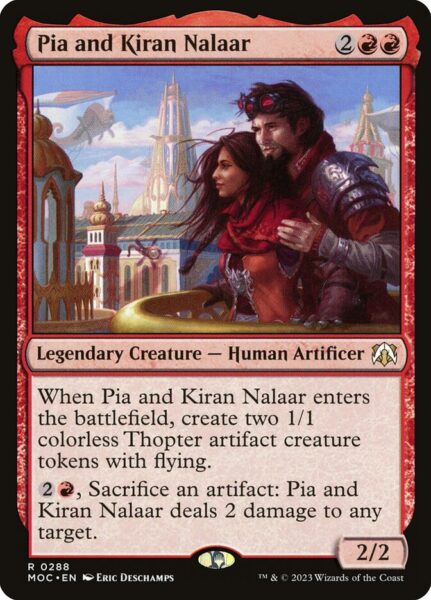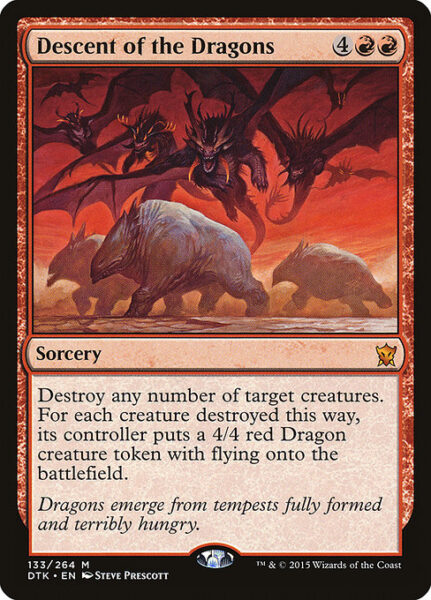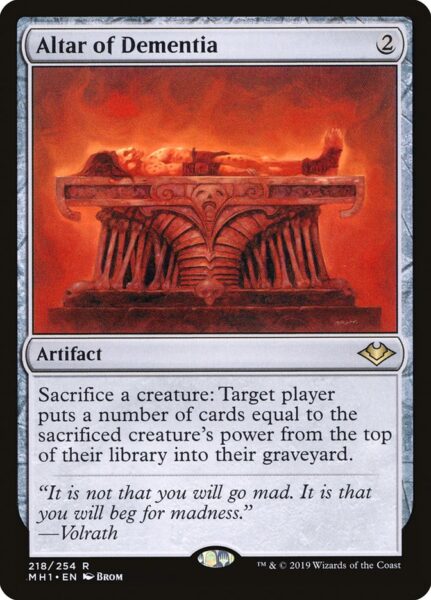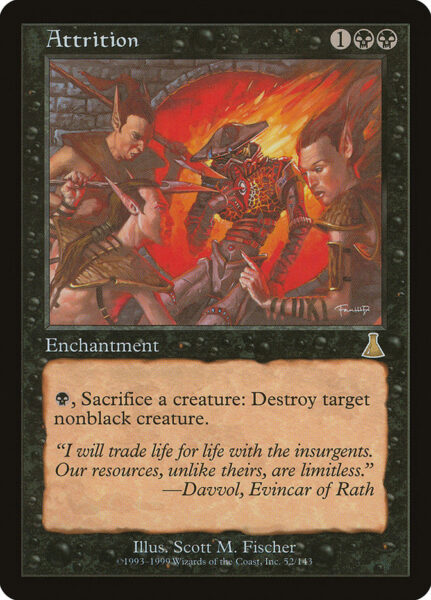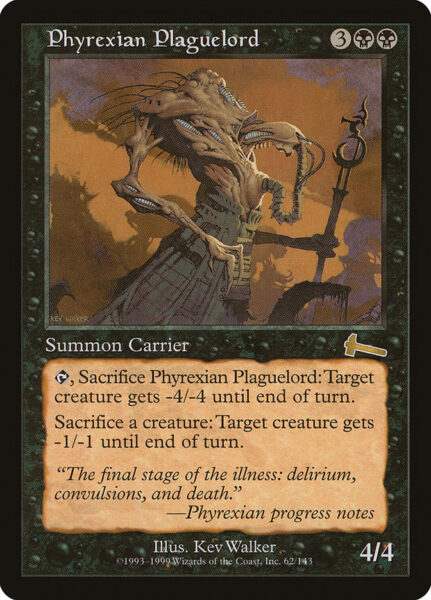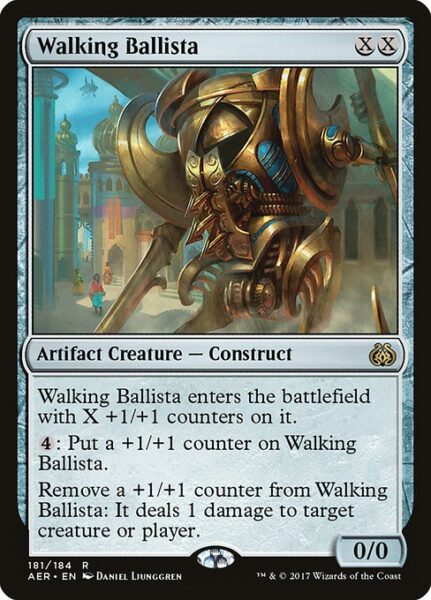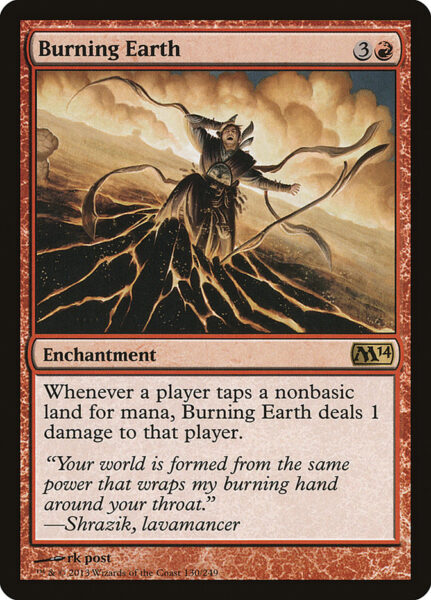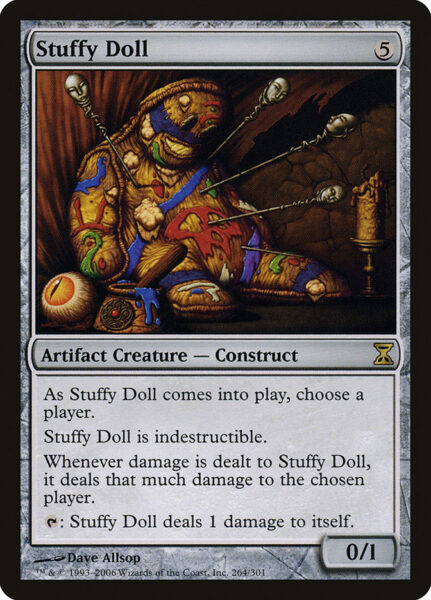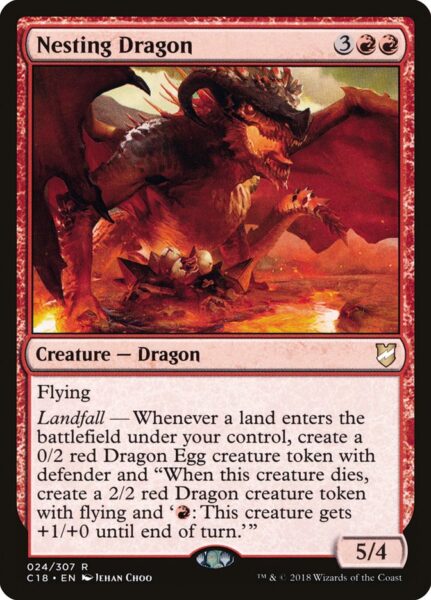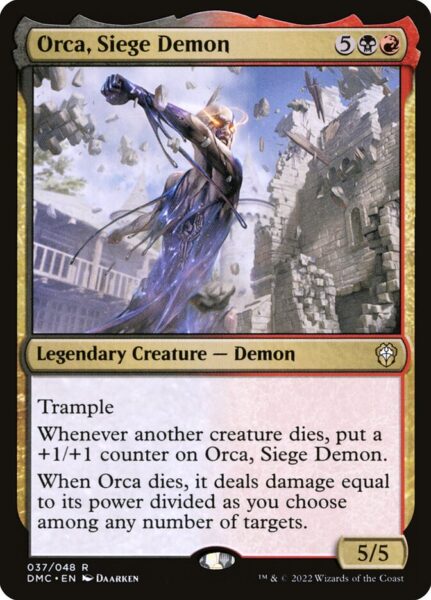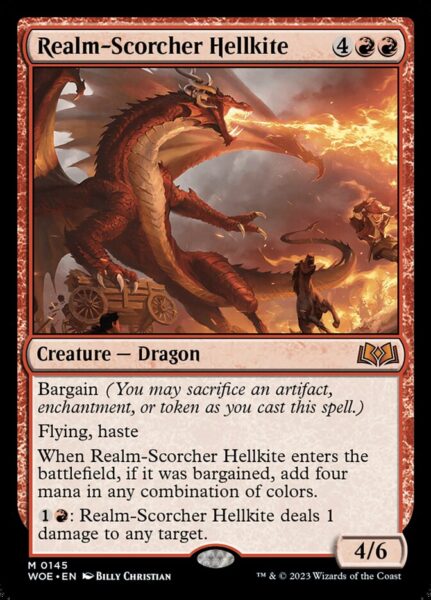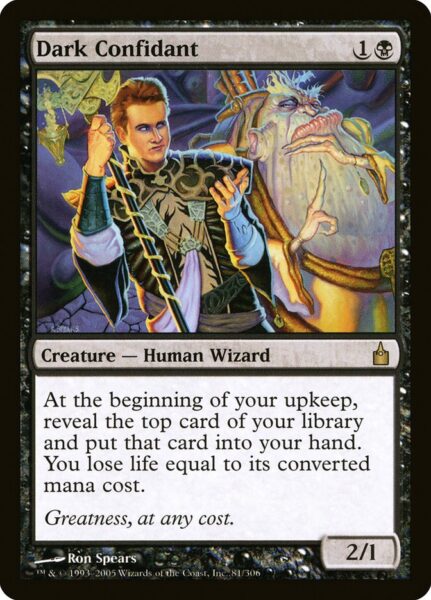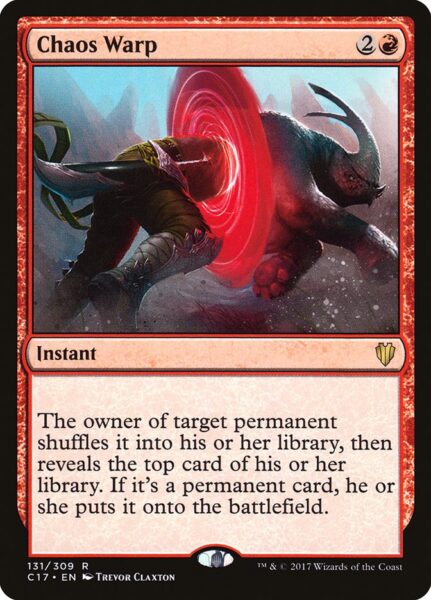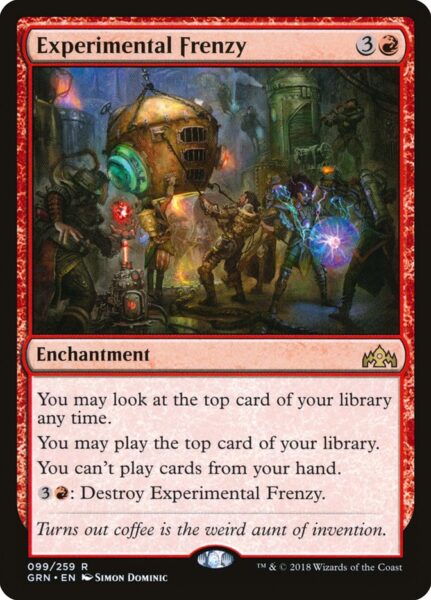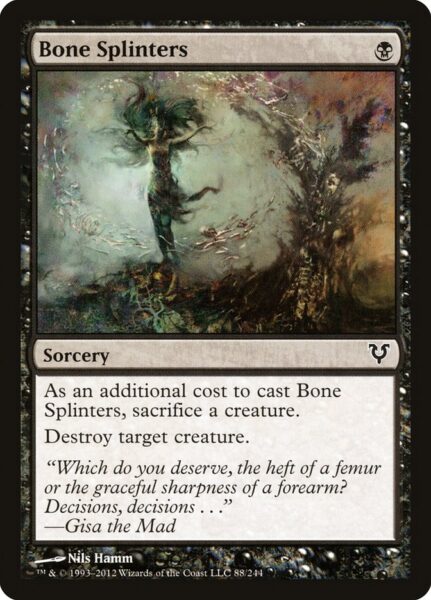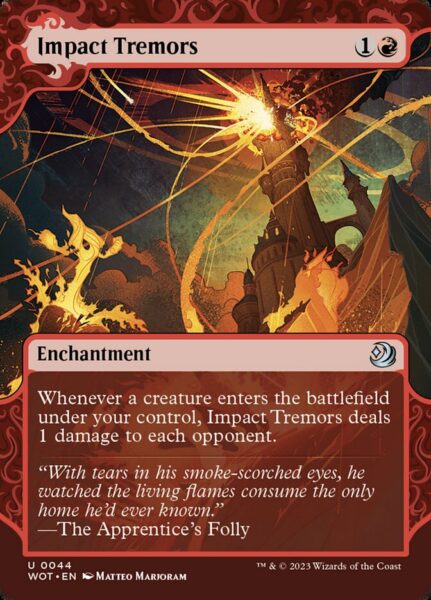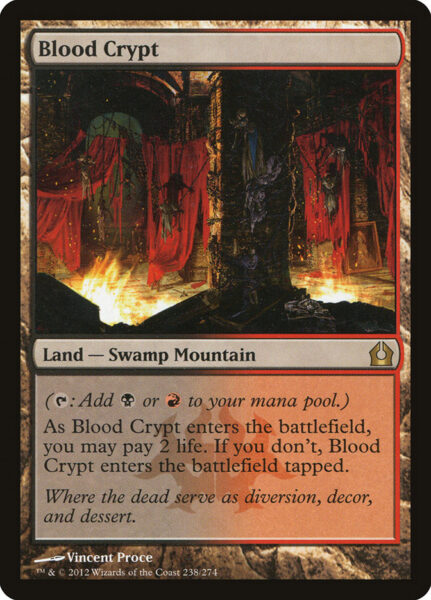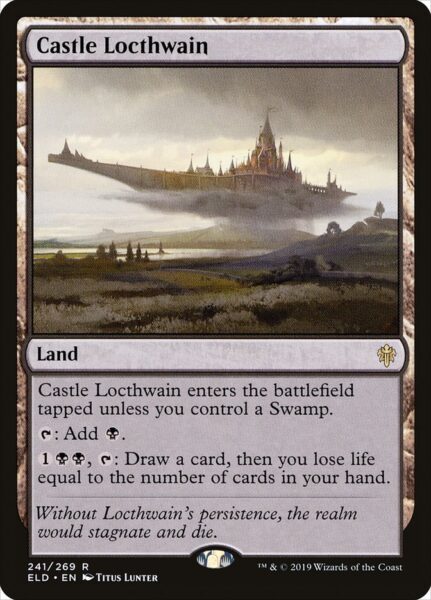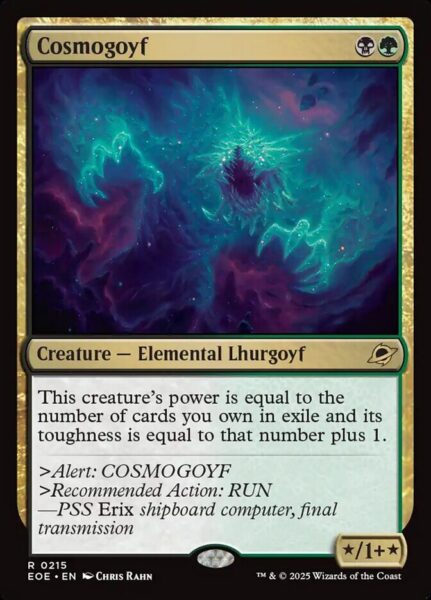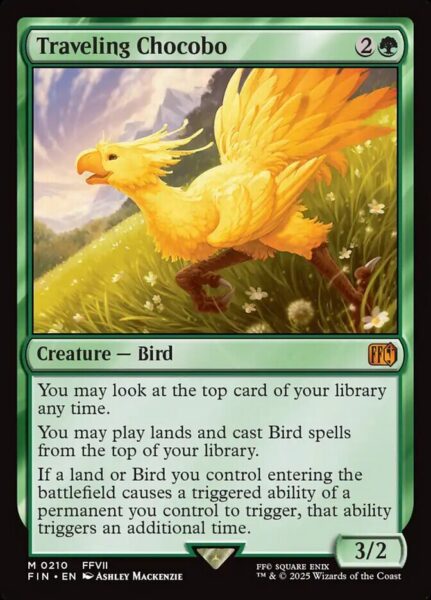by Johnny Cycles, November 10th, 2023
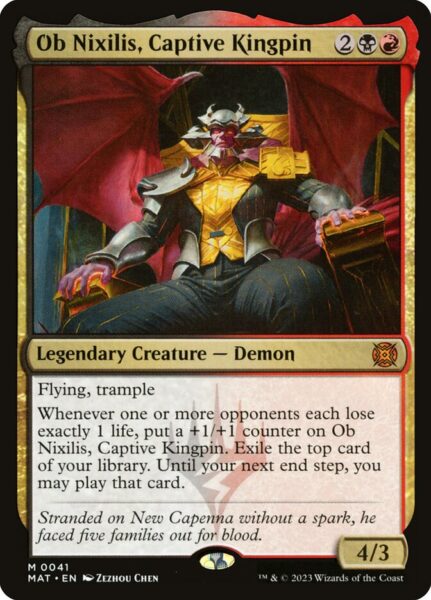
Want to play an Aristocrat-style deck that has the potential to 1-shot your opponent? Enjoy powerful synergies fueled by underpowered cards most opponents will have to read upon resolution? Like the beautiful melody of the 2-note song, “Take 1”? Then this is the deck for you!
Decklist – Rakdos Aristocrats with Ob Nixilis, Captive Kingpin
| Ob Nixilis, Captive Kingpin |
Creatures (24)
| Disciple of the Vault | |
| Viscera Seer | |
| Blood Artist | |
| Orcish Bowmasters | |
| Zulaport Cutthroat | |
| Ayara, First of Locthwain | |
| Grim Haruspex | |
| Grima Wormtongue | |
| Judith, the Scourge Diva |
Planeswalkers (4)
| Ob Nixilis, the Adversary | |
| Tibalt, Rakish Instigator | |
| Zariel, Archduke of Avernus | |
| Angrath, the Flame-Chained |
Artifacts (2)
| Ashnod’s Altar | |
| Phyrexian Altar |
Enchantments (22)
| Tainted Remedy | |
| Underworld Dreams | |
| Blood Reckoning | |
| Dogged Pursuit | |
| Grave Pact | |
| Leyline of Lightning | |
| Outpost Siege | |
| Revenge of Ravens | |
| Spiteful Visions | |
| Dictate of Erebos |
Instants (1)
| Dance with Devils |
Sorceries (9) with 2 mfdcs
| Demonic Tutor | |
| Diabolic Intent | |
| Feed the Swarm | |
| Agadeem’s Awakening (mfdc) | |
| Bloody Betrayal | |
| Hijack | |
| Traitorous Blood | |
| Twisted Fealty | |
| Burn Down the House | |
| Song-Mad Treachery (mfdc) |
Lands (38) with 2 mfdcs
| Agadeem, the Undercrypt (mfdc) |
| Barad-dûr |
| Blackcleave Cliffs |
| Blighted Fen |
| Blood Crypt |
| Bojuka Bog |
| Canyon Slough |
| Castle Locthwain |
| Command Tower |
| Dragonskull Summit |
| Field of Ruin |
| Graven Cairns |
| Hanweir Battlements |
| Haunted Ridge |
| High Market |
| Kher Keep |
| Luxury Suite |
| Mount Doom |
| Phyrexian Tower |
| Sokenzan, Crucible of Defiance |
| Song-Mad Ruins (mfdc) |
| Spawning Bed |
| Takenuma, Abandoned Mire |
| Temple of Malice |
| Urborg, Tomb of Yawgmoth |
| Westvale Abbey |
| Mountain (6) |
| Swamp (6) |
Building an Aristocrat Deck in Commander
The first competitive deck I played after returning to Magic in 2011 was Mardu Aristocrats, featuring the synergistic powerhouses Doomed Traveler, Skirsdag High Priest, Lingering Souls, and Blood Artist. The deck derives its name from Falkenrath Aristocrat and Cartel Aristocrat and refers to the style of play that wants to sacrifice one’s own creatures for value.
The goal was to flood the board with cheap creatures that would serve as fodder for our aristocrats to sacrifice in order to slowly drain our opponent out of the game or to make 5/5 flying Demon tokens (as early as turn 3) and beat face. The deck even ran the alternate win condition of Boros Reckoner and Blasphemous Act! In many ways, the Aristocrat archetype is a janky player’s dream. We get to play underpowered, fun, and flavorful cards that come together to do busted and powerful things.
Unfortunately, I’ve had a difficult time porting the Aristocrat archetype into Commander. As a format, Commander plays the kinds of grindy, long games that allow us to set up our many synergistic pieces. However, it also features late-game bombs that make our big threats seem paltry by comparison. Not to mention 40 life is a lot when we’re draining for a single point of damage per sacrificed creature. Playing a bunch of cards that are greater than the sum of their parts against decks running Krenko, Mob Boss, Edgar Markov, Atraxa, Praetors’ Voice, or Narset, Enlightened Master as their commander frequently felt like playing with one hand behind my back.
Blood Artist and friends pale in comparison to what these decks can do…
Luckily, Wizards printed the answer in Ob Nixilis, Captive Kingpin. Before we jump into the deck, though, let’s talk a little about the Aristocrat archetype.
For an Aristocrat strategy to work, we need three essential parts. First, we want fodder for sacrifice. For this, we’re looking for ways to flood the board with cheap creatures, preferably tokens from cards such as Bitterblossom, which make a 1/1 Faerie Rogue token each turn, or from spells that give us 2 or more creatures, such as Mogg War Marshal or Thatcher Revolt. Second, we want ways to sacrifice them for value outside of combat, such as Viscera Seer, Yawgmoth, Thran Physician, or the aforementioned Falkenrath Aristocrat. Third, we need ways to punish our opponent when our creatures die, with cards like Blood Artist and Zulaport Cutthroat.
Finding the right balance of these three types of cards is the central task of any Aristocrat-style deck.
The first commander I tried was Judith, the Scourge Diva. It quickly became evident that she was not a good fit for the kind of Aristocrat deck I wanted to play. First, she is too fragile with just 2 toughness and too weak with 2 power. Winning via commander damage with Judith, the Scourge Diva would only happen on the rarest of occasions. Of course, winning through combat has never been the primary win condition for Aristocrat decks; draining and pinging for 1 is.
Which leads us to the second problem with Judith, the Scourge Diva – she’s too unimpactful. She, herself, doesn’t give us a sacrifice outlet, and she only deals damage when one of our nontoken creatures dies, rather than when any creature dies. Running out of threats and cards and then dying was how many games with her at the helm played out. The chief issue with Judith, however, is she incentivizes two strategies – sacrifice and aggro – that tended more often than not to be at odds with one another rather than in harmony. Furthermore, since her death trigger doesn’t work with nontoken creatures, we weren’t even able to get full value out of all the many token producers there are in Magic. For these reasons, with Judith, the Scourge Diva we need not just three things to be successful, but rather four: anthems.
This is where I went wrong with my deckbuilding decisions with Judith, the Scourge Diva. Flooding the board with a bunch of 1/1s can get us off to a fast start, particularly after they become 2/1s with our commander out, assuming she isn’t immediately killed. More often than not, though, our opponent is able to weather the storm, stabilize via creatures or a sweeper, and then win with bigger and better bombs than we have. At first, I tried to solve this by increasing the number of top-end creatures to give us our own late game. Cards like Junji, the Midnight Sky, Endrek Sahr, Master Breeder, and Preyseizer Dragon synergize well with our overall strategy, while giving us some powerful enablers and finishers.
All powerful cards, but they just didn’t do enough to make the deck viable.
The issue with these cards is precisely that they synergize with our strategy, meaning we need a board state to take advantage of the power they bring. By turns 5, 6, and later, when we can cast these cards, we are usually in need of rebuilding after our opponent finds a sweeper, rather than bombs that aren’t great on an empty board and which are typically outclassed by what our opponent is doing.
Rather than these top-end finishers, I should have tried more anthem effects. The main reason I did not is purely circumstantial. I have a Mardu Tokens deck with Alesha, Who Smiles at Death that wants to go wide, pump the team, and swing out, all while reanimating more token generators. However, I think there is another reason anthem effects aren’t more commonly played in Aristocrat decks – there isn’t room for them. As detailed above, we need three kinds of cards to make a successful Aristocrat deck. Adding a fourth in anthem effects waters down our combo pieces and makes it less likely we’ll have all the necessary parts to win the game outside of combat. Going wide with a pumped up team of tokens is an effective strategy, of course, but it isn’t really what the Aristocrat deck wants to do. That being said, if you have a Judith, the Scourge Diva Commander deck, I’d love to see your decklist! Email it to me at johnnycycles16@gmail.com.
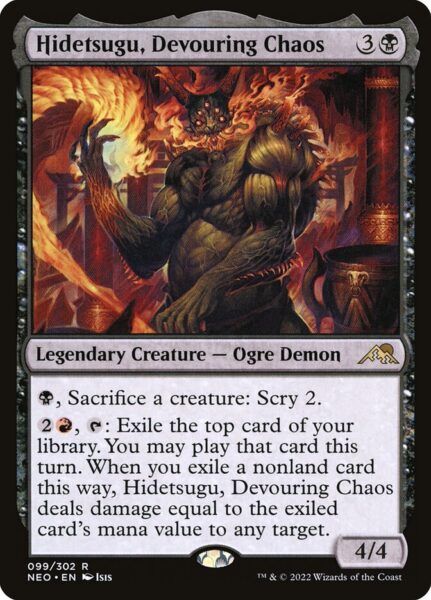
The second commander I tried for this deck was Hidetsugu, Devouring Chaos. He solves two of the problems encountered with Judith, the Scourge Diva, while failing in his own way to do enough. First, he gives us a sacrifice outlet with the added bonus of scrying 2 for each creature sacrificed, which is an extremely powerful effect. Second, he is a source of card advantage. Running out of cards and, therefore, sacrifice fodder, is one of the chief issues with the Aristocrat strategy in general. Hidetsugu, Devouring Chaos not only gives us an additional card each turn, the Ogre Demon also deals damage equal to that card’s mana value. This final bit ameliorates one of the weaknesses of Hidetsugu: he doesn’t do damage when one of our creatures die.
Of course, the chief drawback of Hidetsugu, Devouring Chaos is the mana investment he requires to use these synergistic abilities. A single to scry 2 is a reasonable cost, though Viscera Seer begs to differ. The plus tapping to exile a single card, however, means we will often be left unable to cast whatever card we exile, which largely negates the benefit. The damage the card does isn’t irrelevant by any means, but we will almost always prefer to cast the card and, unless we fill our deck with very cheap spells, we will have to wait until turns 7 and later to consistently accrue card advantage from Hidetsugu, Devouring Chaos.
All that being said, Hidetsugu, Devouring Chaos felt like a step in the right direction with this deck.

Enter Ob Nixilis, Captive Kingpin. This card does nearly everything we need and incentivizes us to play a deck full of Aristocrat-style cards, which is precisely what I wanted. For me, it was the “exactly 1 life” part of the card that flipped the switch and solved the puzzle of building the Aristocrat archetype in Commander. I began looking for every card that drained for 1 or dealt a single point of damage and went from there. It is quite possible that either Judith, the Scourge Diva or Hidetsugu, Devouring Chaos would be successful commanders for this same 99, but Ob Nixilis, Captive Kingpin offers something neither of his predecessors do: a legitimate threat as a finisher via combat.
Flying, trample, and growing himself for each 1 point of damage dealt can transform Ob Nixilis, Captive Kingpin from a valid Lightning Bolt target to a 1-shot killer in a single turn…IN A SINGLE TURN! All of this while drawing us through our deck in search of whatever we need to keep him alive or put the nail in our opponent’s coffin. He is Judith, the Scourge Diva without the necessary army of pumped up attackers and Hidetsugu, Devouring Chaos without the mana requirement.
Furthermore, once I began looking for cards that fit his “exactly 1 life” clause, I was able to move away from the sacrifice theme of the Aristocrat deck into a more general, and often harder to interact with, plan of punishing our opponent for everything from playing creatures to attacking. Doing so means we are no longer dependent on flooding the board with largely underwhelming creatures in order to sacrifice them to kill our opponent. Instead, we play cards that punish our opponent for executing their gameplan and that synergize with our must-kill commander.
That’s not to say I’ve eliminated the sacrifice aspect of the deck or that it isn’t still an essential part of our gameplan. This is still an Aristocrat deck and Ob Nixilis, Captive Kingpin synergizes beautifully with the Blood Artist effects of the traditional Aristocrat archetype. However, his “exactly 1 life” clause makes us less reliant on sacrificing our creatures to kill our opponent, allowing us to diversify our threats in a way that makes the deck more resilient, more powerful, and faster. Finally, Ob-Nixilis functions similarly to Falkenrath Aristocrat in my Mardu deck as a top-end finisher that brings both the power and evasion many of the other cards in the deck lack. He does even more, though, in drawing us cards to ensure we won’t run out of fuel or the pieces we need to function successfully as an Aristocrat deck.
Now that I’ve convinced you of the superiority of Ob Nixilis, Captive Kingpin, let’s get to the deck!
The Deck
As detailed above, an Aristocrat deck needs three things to synergize and win games: fodder for sacrifice, a sacrifice outlet, and a way to gain value, usually via hurting our opponent, for each creature sacrificed. With all the cards Commander has to choose from, we get to play some truly fun, powerful, and synergistic cards that more often than not perform multiple roles in our deck.
Fodder for Sacrifice
The power of Ob Nixilis, Captive Kingpin allows us to be less reliant on flooding the board with creatures to sacrifice, but killing our own things is still an important angle of attack for our deck. In fact, there will be times when sacrificing our entire board, except Ob Nixilis, will be game ending. But what’s better than sacrificing our creatures? Stealing our opponent’s threats, attacking with them, and then feeding them to the synergies of our deck.
Angrath, the Flame-Chained – our first of several cards that take our opponent’s creature for us to sacrifice, Angrath, the Flame-Chained is one of my favorite cards. It’s a fiery, flaming pirate minotaur. What’s not to like? However, 5 mana is a lot for this kind of effect. I could see cutting it for something cheaper if you aren’t as smitten with it as I am.
Bitterblossom – it’s hard to believe this card used to be great in Modern. That being said, its $20 price tag suggests it sees a decent amount of play in Commander, most likely in Faerie Tribal and Aristocrat/Sacrifice decks, where it is one of our best fodder generators. A creature a turn for a 1-time investment of 2 mana makes this card an auto-include.
Bloody Betrayal – Wizards has printed numerous cards like this and they all function almost identically. At sorcery speed, we gain control of target creature an opponent controls and untap it, it gains haste, then we return it at the end of turn. Of course, we have no plans of giving the creature back. Insert maniacal laughter. And since Wizards keeps printing this kind of card, they have started to push the power level. Bloody Betrayal also gives us a Blood token, which means we are getting both sacrifice fodder and card draw out of a single card. Thank you power creep! The Blood token is also something we can sacrifice, which synergizes with cards like Mayhem Devil and Disciple of the Vault.
Burn Down the House – another flexible card, we get a conditional sweeper to help stabilize in the right spot, or 3 1/1 hasty Devil tokens that deal 1 damage to any target when they die. With a single Blood Artist effect on the battlefield, sacrificing one of these devils gives us two Ob Nixilis, Captive Kingpin triggers. Feeding all three to the beast gives us 6! SIX! That’s 6 cards in exile for us to play and Ob Nixilis is now a 10/9. Still with flying. Still with trample. But let’s take a moment and live the dream with the following cards on the battlefield.
Synergistic Aside #1
Remember, I’m a former Russian literature professor, so I’ll take the math slowly and carefully. We cast Burn Down the House and make 3 Devil tokens. That triggers Mirkwood Bats 3 times, growing Ob Nixilis, Captive Kingpin +3/+3. He’s now a 7/6. It also triggers Impact Tremors 3 times, growing him an additional +3/+3. He’s a 10/9 and each opponent has taken 6. Now, we sacrifice all three Devil tokens to Viscera Seer. With each death, we scry 1, ping our opponent for 1 thanks to the Devil token, drain our opponent for 1 twice, thanks to Blood Artist and Bastion of Remembrance, and, finally, ping our opponent for 1 thanks to Mirkwood Bats. Each Devil we sacrifice, then, deals 4 damage and triggers separately, thus growing Ob Nixilis, Captive Kingpin +4/+4. Now let me get my calculator out, as this math is too challenging…
3 Devils…2 Blood Artist effects…Mirkwood Bats…that’s 12 total damage dealt, 6 life gained, 12 +1/+1 counters on Ob Nixilis, Captive Kingpin, and 12 more cards in exile for us to cast this turn (not that we’ll be able to). So, with this board state and a single Burn Down the House, we will deal 12 damage to each opponent (18 to one since both Blood Artist and the Devil tokens have a single target only), gain 6 life, scry 3, and grow Ob Nixilis, Captive Kingpin from a 4/3 to 22/21. That’s a 1-shot, lethal attack, all while exiling 18 cards we can play this turn.
Now before you talk about the odds of assembling a 7-card combo, or of Ob Nixilis, Captive Kingpin not drawing out a kill spell somewhere along the way, just look at the pieces we’re using. Not a single one is terrifying on its own. Not a single one is game-ending by itself if left unanswered. Two are enchantments and will survive traditional sweepers. Two of our creatures are 2 mana or less, while all three are innocuous enough for the table to ignore for more pressing, powerful threats. Yes, Ob Nixilis, Captive Kingpin is a legitimate target, but as a 4/3, his stats are largely underwhelming compared to many commanders and certainly compared to the kinds of bombs people will be playing by turn 7, which is about as early as we can have this kill assembled. As to the pieces themselves all being on the battlefield at once, keep reading and see just how redundant some of them are. But for now, revel with me in the power and the synergy and the sheer beauty of what this deck can do.
Now back to our regular scheduled programming.
Dance with Devils – 4 mana is a lot, but as detailed above, making tokens that deal 1 damage upon death is superpowered in a deck like this. Also, it’s an instant, which gives us some flexibility in playing against counter magic or sweepers.
Grima Wormtongue – with 10 legendary targets to sacrifice, this Human Advisor has the potential to replace the sacrificed creature with additional fodder.
Hijack – another way to steal our opponent’s best creature for fodder to sacrifice, we get the added bonus of being able to take an artifact.
Lagomos, Hand of Hatred – this Human Shaman gives Bitterblossom a run for its money as best fodder generator. We get a 2/1 hasy creature with trample that sacrifices itself each turn. Not needing a sacrifice outlet to get a death trigger can be very relevant.
Ob Nixilis, the Adversary – we are almost always going to make a 1/1 Devil token with this Planeswalker. I’m beginning to wonder if we shouldn’t call this deck Devil Tribal. This Ob Nixilis does double duty as a 1-time means of sacrificing something, which is sometimes all we need.
Playing against Angel Tribal? Want a copy of Ob Nixilis, the Adversary with 5 starting loyalty? We can do that!
Song-Mad Treachery – at 5 mana, this effect is super overcosted, but since it’s on the back of a land, it’s an auto-include.
Tibalt, Rakish Instigator – more Devil token generation, this time with the added bonus of nerfing lifegain, which is one of the best strategies against what we’re doing, as I’ll discuss later.
Traitorous Blood – the creature we steal gets trample…we’ll take it!
Twisted Fealty – more power creep for this effect, this is probably our best steal card. We can attach the Wicked Role token to the creature we take so that when we sacrifice it, we get an additional Ob Nixilis, Captive Kingpin trigger.
Woe Strider – primarily in the deck as a free sac outlet, it does bring a Goat token with it.
Zariel, Archduke of Avernus – a powerful Planeswalker in our deck, we will more often than not use her 0 to make a Devil token. However, pumping our team and granting haste can give us a janky beats win in the right spot.
Zealous Conscripts – ever wanted to steal your opponent’s Planeswalker the turn before they get to ultimate it? This Human Warrior is for you!
The above cards are just our ideal fodder generators. Don’t forget that any of our creatures can be sacrificed. For those of you familiar with the Aristocrat archetype, you’ll remember that oftentimes the turn we win will see us sacrifice virtually our entire board. After all, who needs a board state once you’ve won?
We also play several lands that can make creatures for us to feed to the machine.
Barad-dûr – a lot of hoops to jump through, but in a deck like ours, we should be able to amass some orcs every turn if we want to.
Kher Keep – Devil and Kobold tokens? This deck works on so many levels!
Sokenzan, Crucible of Defiance – two Spirit tokens at instant speed.
Spawning Bed – the motley token crew continues recruiting members, this time Eldrazi Scion tokens.
Westvale Abbey – a favorite card of mine that I’ve rarely gotten to flip into its big, bad Demon backside, this land functions as both sacrifice fodder, a sacrifice outlet, and a win condition. Seriously, what more could we ask for?
For those new to Magic, having non-mana effects like these attached to a mana source is huge for any deck. We are functionally getting two cards for one with lands like Barad-dûr and Kher Keep, while Sokenzan, Crucible of Defiance and Spawning Bed help ameliorate flooding. Westvale Abbey, meanwhile, puts them all to shame with everything it brings to the table.
Sacrifice Outlets
Every good Aristocrat deck needs ways to sacrifice creatures for value and we are no different, no matter the fact that our commander gives us a different axis of attack. Without a sac outlet, when and if our creatures die will be left up to our opponent and our many Hijack-type cards lose much of their power. That being said, sometimes swinging out with a bunch of Devil tokens while having multiple Blood Artist effects on the battlefield will put our opponent between the proverbial rock and hard place, having to decide between not blocking and dying to damage or blocking and dying to Blood Artist triggers. This is one of our many happy places.
Our best sac outlets are those we can use repeatedly in a given turn with no mana investment. We play five of those, and an additional two more that can be used as many times as we can pay. Our next best sac outlets are those we can use once each turn. Finally, we play a few sweepers that synergize with our deck in other ways, while also functioning as a 1-shot sacrifice outlet.
Vampiric Rites – for we get to sacrifice a creature, gain a life, and draw a card, and that’s not counting the kinds of synergies we will most likely have on the battlefield with our other permanents. Note, we can do this as many times as we have mana.
Viscera Seer – another repeatable sac outlet, this time for free, we also get to dig for whatever we need, on top of our other synergies.
Diabolic Intent – a Demonic Tutor that synergizes with our gameplan? More please!
Goblin Bombardment – its synergies with Goblin Tribal made me overlook this card for awhile, but it fits perfectly with our strategy, despite the name. If only it were called Devil Bombardment…
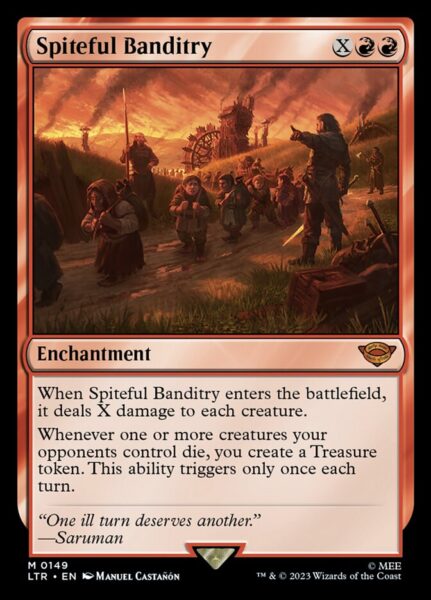
Spiteful Banditry – I keep waiting for this card to spike in price once everyone realizes just how busted it truly is. Sure, it only makes a single treasure a turn no matter how many of our opponent’s creatures die, and so is not as powerful as a card like Smothering Tithe, but even making a Treasure on each of our opponent’s turns will put us ahead on mana quickly. In a deck like ours, it can sweep away our own creatures if we’re missing a true sacrifice outlet, while its token generation synergizes with Mirkwood Bats, Nadier’s Nightblade, and Disciple of the Vault, giving us an alternate angle of attack.
There’s nothing spiteful about this kind of banditry…
The Meathook Massacre – another 1-time means of killing our own creatures, this enchantment comes with the added bonus of being a convoluted Blood Artist…
Ashnod’s Altar – one of our best sac outlets, we get 2 colorless mana and can activate any number of times. Every time I think of this, I consider including a card like Banefire in the deck to live the dream of sacking our board to fuel a massive Fireball to our opponent’s dome.
Ayara, First of Locthwain – a sac outlet that draws us cards? Thank you very much. Oh, and it also drains our opponent whenever it or another black creature enters the battlefield? It must be from Eldraine… As I will discuss below, shutting down death triggers can really hamstring our deck. This Elf Noble gives us a different way to trigger Ob Nixilis, Captive Kingpin.
Grima Wormtongue – another card that gets around Rest in Peace effects, this Human Advisor also shuts down lifegain shenanigans, while potentially giving us more fodder to sacrifice. Gotta love power creep!
Ob Nixilis, the Adversary – a 1-time sacrifice outlet, we do get an additional Planeswalker out of it.
Phyrexian Altar – why sacrifice a creature for 2 colorless when you can sacrifice it for a mana of any color?
Woe Strider – a more expensive Viscera Seer, we get a recursive 3/2 and a Goat token for two additional mana. I’d say that’s a deal!
Yawgmoth, Thran Physician – a repeatable sac outlet that kills creatures and draws us a card. And that’s only part of all the text on this Modern staple.
We play two lands that let us sacrifice our creatures for value.
High Market – the lifegain is nice. I’d rather it ping our opponent, though.
Phyrexian Tower – at the low cost of a single creature. This land can let us pull ahead on board by casting more than one thing a turn before our opponent.
Blood Artist Effects
Blood Artist was the OG finisher for Aristocrat decks, draining our opponent for 1 for each creature sacrificed. Since the Vampire first appeared in Avacyn Restored, Wizards has printed a variety of similar effects, many of which don’t target a player, but rather drain each opponent. This is a direct result of Commander’s burgeoning popularity. Thanks to this, we have many great options and our deck is full of ways to deal a single damage to our opponent, many of which do not require a death trigger, the way Blood Artist does. I’m lumping them all under Blood Artist effects for the sake of simplicity, though they are very much, and intentionally so, not all the same. This diversity of threats insulates us from graveyard hate, in particular, while giving us multiple ways to deal a single point of damage in a turn that don’t all require a creature dying. Furthermore, we have several ways to punish our opponent, 1 point at a time, for executing their own gameplan.
Creatures Dying
These are the cards most like Blood Artist, in that the majority drain our opponent 1 life for each death trigger, while gaining us 1 life. There is some variation that I’ll point out along the way, but there are two important things to mention before we get started. First, this kind of effect typically triggers either when one of our creatures dies, or when any creature dies. Obviously, the latter is more powerful. Second, many of the cards in this group are enchantments. Not being a creature helps protect us from sweepers and spot removal and is crucial to establishing and maintaining our synergies. When deciding which cards to include in your deck, I recommend diversifying the card types for this reason.
Bastion of Remembrance – an enchantment that drains only when a creature we control dies, rather than any creature, it comes with the bonus of making a 1/1 white Human Soldier token.
Blood Artist – what more is there to say about the namesake card of this effect? Blood Artist set the gold standard for finishers in the Aristocrat archetype. The only criticism we can level at the Vampire is that he doesn’t drain each opponent.
Garna, Bloodfist of Keld – drawing a card or dealing 1 damage to each opponent? This is the definition of a win-win, all on a 4/3 body.
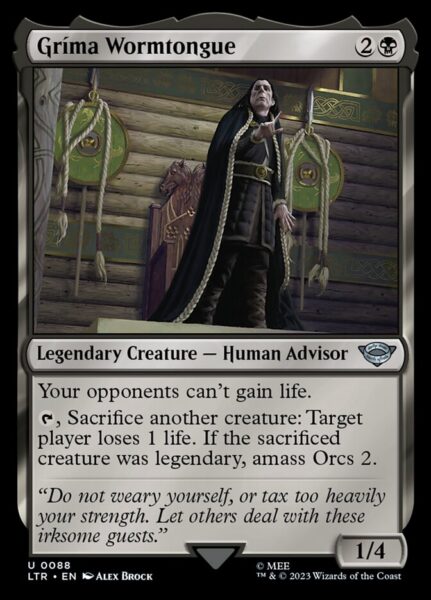
Grima Wormtongue – shutting down lifegain, while functioning as both sac outlet, pinger, and fodder maker. That’s 4 things we want to do in our deck, all in one uncommon. Wow! We play 10 total legendary creatures that will trigger Grima Wormtongue‘s last ability. Of most importance, perhaps, is this is the first of our unique abilities that do NOT trigger on death. The text says, “Sacrifice another creature,” rather than the traditional, “whenever a creature you control dies.” This gives us another way to play around cards like Rest in Peace and Hushbringer.
Judith, the Scourge Diva – not making the cut as our commander doesn’t mean Judith isn’t good enough for the 99. One drawback: only nontoken creatures we control trigger her. One benefit: we can target anything, giving us some spot removal in a pinch.
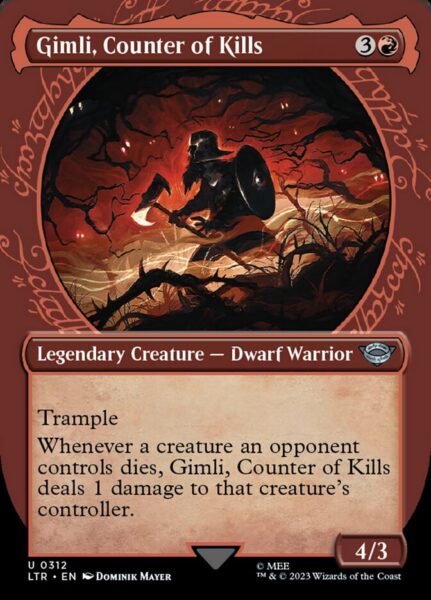
Gimli, Counter of Kills – a unique effect in this list, Gimli only triggers when a creature an opponent controls dies. This is a great flavor win and effective against decks looking to get value out of killing their own creatures…like ours. Trample is just gravy.
Outpost Siege – another enchantment, this one gives us flexibility depending on our needs. Short on cards? Pick Khans. Need a Blood Artist effect? Pick Dragons. Finally, we can also target creatures with Outpost Siege, giving us some spot removal for must-kill threats.
Spiteful Prankster – can target a player or a Planeswalker whenever another creature dies. Devils don’t gain us life; vampires do. Another flavor win!
Syr Konrad, the Grim – man that’s a lot of text…We mostly want this card for the first four words, but we’ll take the rest! There are plenty of strategies and commonly played cards that this Human Knight will punish with all those additional abilities, though.
The Meathook Massacre – an oddly worded sweeper, we gain life when our opponent’s creatures die, and our opponent loses life when our creatures die.
Vindictive Vampire – 4 mana for a 2/3 body that hits each opponent, but only when one of our creatures die. Falkenrath Noble may be the better option.
Zulaport Cutthroat – an almost Blood Artist, it triggers only when a creature we control dies. Good thing we have lots of fodder for sacrifice.
Tokens Matter
These cards only trigger when a token is involved. Sounds kind of meh until you realize it’s any token, not just creature tokens.
Mirkwood Bats – as detailed above, we get the trigger both when we create and sacrifice a token.
Nadier’s Nightblade – a Blood Artist effect whenever a token “leaves” the battlefield, this card will trigger when our opponent exiles all of our Treasure tokens with Farewell.
We have 14 ways of making tokens, all of which synergize in other ways, like this one:
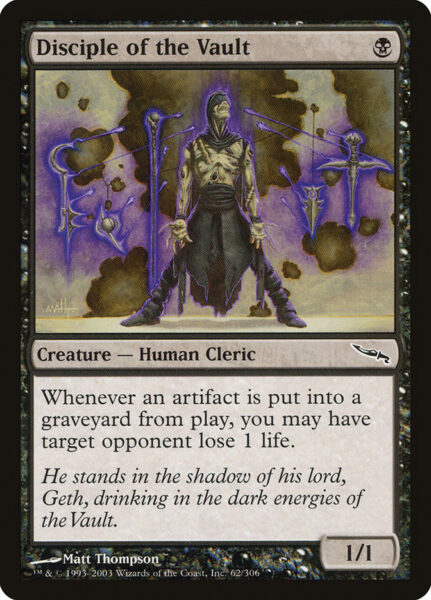
Artifacts Matter
The only one of its kind in our deck, Disciple of the Vault can do some major work against commonly played cards (looking at you, Smothering Tithe). In our own deck, the Human Cleric synergizes with our Treasure token producers, like these:
I’ve mentioned how Ob Nixilis, Captive Kingpin opened my eyes to building a competitive Aristocrat deck in Commander, but the synergy of the above cards would work with any commander at the helm. Let me take a moment to show just how powerful these non-traditional Blood Artist-type cards can be.
Synergistic Aside #2
Let’s say we have 3 Faerie Rogue tokens on the battlefield, along with Disciple of the Vault, Mayhem Devil, Pitiless Plunderer, and Mirkwood Bats. We cast Ashnod’s Altar and sacrifice the 3 Faerie Rogue tokens, triggering Mayhem Devil 3 times. We get 6 colorless mana, deal 3 more damage with Mirkwood Bats, create 3 Treasure tokens with Pitiless Plunderer, which triggers Mirkwood Bats for another 3 damage. We’ve now dealt 9 damage. Now let’s sacrifice our Treasure tokens for 3 mana of any color. This triggers Disciple of the Vault, Mayhem Devil, AND Mirkwood Bats for a total of 9 more damage. That’s 18 damage, while we have 9 total mana left over to use to cast whatever the best cards are from the 18 we exiled with Ob Nixilis, Captive Kingpin, who now happens to be a 22/21.
It’s these kinds of synergies that make the deck so much fun to play, not to mention so powerful.
Sacrificing Permanents
Mayhem Devil – other than punishing players looking to abuse Treasure tokens, this Devil also deals 1 damage whenever someone cracks a fetch or casts cards like Diabolic Intent or Bone Splinters.
Punishing Combat
We have 4 ways of making combat even more painful for our opponent, all of which will trigger Ob Nixilis, Captive Kingpin.
Blood Reckoning – one of our alternative ways of dealing a single damage that don’t involve a death trigger. We don’t get to control when we get the triggers, but this enchantment does make attacking us for anything short of lethal less appealing.
Cavalcade of Calamity – we have 10 creatures with power 1 or less, but we won’t be too interested in attacking with them until we’re ready to win. We do, however, have all those ways of making 1/1 Devil tokens we want to die, not to mention Bitterblossom.
Hellrider – one of my favorite cards from when I first started playing Magic again, I was never able to punish my opponent with this Devil the way I had dreamed. Now is the time and this deck is the place for Hellrider to shine!
Revenge of Ravens – a better Blood Reckoning, this one gains us a life, too. Shockingly, it’s from Throne of Eldraine…
Enters the Battlefield
Who needs creatures to die to deal a single point of damage when we can get the same result from bringing creatures to life? These cards both punish our opponent for playing Magic, while giving us an alternative way to trigger Ob Nixilis, Captive Kingpin. Noticing a trend in this section yet?
Ayara, First of Locthwain – only drains our opponent when a black creature enters the battlefield under our control. Good thing we are playing more than 20 black creatures.
Impact Tremors – an enchantment that can come down as early as turn 2, this is one of our best alternative ways to trigger our commander and punish our opponent.
Trespasser’s Curse – why should our opponent get to play creatures without repercussion?
Drawing Cards
Everyone loves drawing extra cards. Let’s make them pay.
Orcish Bowmasters – seemingly custom made for a deck like ours, each extra card drawn is a separate trigger. Sphinx’s Revelation for 5? Take 1 damage 5 times and we’ll grow Ob Nixilis, Captive Kingpin +5/+5, exile 5 cards of our own to play, and get a 5/5 orcish army.
Spiteful Visions – another way to punish our opponent just for playing Magic. This effect hits everyone equally. It’s a pet card of mine that I keep trying to find a home for. Search over.
Underworld Dreams – another way to get value out of our commander for the low, low cost of our opponent completing their draw step.
Playing Lands
Retreat to Hagra – a way to get value out of our commander for each of our land drops. Mayhem Devil + fetch lands + this enchantment = sad opponent.
1 Damage, No Hoops Necessary
Sometimes it pays to deal 1 damage without all the death triggers or other nonsense.
Dogged Pursuit – 4 mana is a lot, but it’s an enchantment and requires nothing more than living through our end step to trigger.
Forsaken Wastes – want a card almost everyone will have to read upon resolution? Forsaken Wastes is for you! Not to mention the art is amazing. Oh, and it shuts down lifegain and synergizes with our commander.
Leyline of Lightning – okay, so there is a small hoop with this one, but for the low cost of , any spell we cast, regardless of resolution, deals 1 damage.
Roiling Vortex – while it’s the first line of text we’re most interested in, the rest is far from irrelevant. Stopping lifegain can be the difference between winning and losing in a deck like this one.
Removal
When building this deck, I didn’t think of it as having much removal. Perhaps this is because the Aristocrat archetype is traditionally light on kill spells, or because we are essentially a combo deck that needs a lot of redundancy of its pieces to win, or both. However, as I’ve pulled all the cards that can function as removal, I’m surprised to say that we play a total of 18 such spells, not counting the Devil tokens that can deal 1 damage to any target. Granted, most are conditional removal, but in a deck like ours, the necessary conditions are easily met.
Rather than discuss each one, since I’ve mentioned most already, I’ll simply list them based on category.
Steal and Sacrifice
| Bloody Betrayal | |
| Hijack | |
| Traitorous Blood | |
| Twisted Fealty | |
| Angrath, the Flame-Chained | |
| Song-Mad Treachery | |
| Zealous Conscripts |
Sweepers
| Spiteful Banditry | |
| The Meathook Massacre | |
| Burn Down the House |
1 Damage at a Price
| Orcish Bowmasters | |
| Judith, the Scourge Diva | |
| Mayhem Devil | |
| Outpost Siege | |
| Yawgmoth, Thran Physician |
Mutually Assured Destruction
| Grave Pact | |
| Dictate of Erebos |
These latter two enchantments can be particularly brutal for opponents to play against, essentially locking them out of playing creatures until they find an answer, all while we continue executing our gameplan.
Answer to Rest in Peace
| Feed the Swarm |
Yes, we’ve diversified our threats and can trigger Ob Nixilis, Captive Kingpin a variety of ways that don’t involve a death trigger or permanents hitting the yard, but Rest in Peace and cards like it do hamstring us significantly. Given Feed the Swarm is also targeted removal for problematic creatures (does anyone play Anafenza, the Foremost?), including it in a deck like this is a no-brainer.
Which leads me to the next section…
Hate for the Hate
We need answers primarily to lifegain and cards that nerf our death triggers. Lifegain can undo a lot of the incremental damage we do over the course of a game and put too much pressure on Ob Nixilis, Captive Kingpin to grow to giant proportions. Meanwhile, shutting down our graveyard with cards like Rest in Peace and Leyline of the Void will make us too reliant on our other angles of attack and, depending on our draw, we may just be the walking dead once graveyard hate resolves. This is the risk we take with an Aristocrat style deck. Let me know in the comments how you deal with graveyard hate in your Rakdos build!
| Forsaken Wastes | |
| Grima Wormtongue | |
| Tainted Remedy | |
| Tibalt, Rakish Instigator | |
| Roiling Vortex |
The Rest
Card draw, graveyard recursion, and tutors fill out the remainder of the deck. Many of these effects are attached to creatures we’ve already discussed. Demonic Tutor, Grim Haruspex, and Agadeem’s Awakening are the three cards that we have not mentioned.
I’ve highlighted the synergies between Pitiless Plunderer, Mahadi, Emporium Master, and cards like Mirkwood Bats and Disciple of the Vault, but I want to reiterate the power of these cards in a deck like ours, but for a different reason. As powerful as Ob Nixilis, Captive Kingpin is, oftentimes we will be unable to play many of the cards we exile with him, especially if we trigger him several times. The Treasure tokens we can accrue with Pitiless Plunderer and Mahadi, Emporium Master give us the ability to play more of those exiled cards. The Human Pirate is the more powerful of the two, but both give our Rakdos deck its own version of Smothering Tithe.
Flex Spots
We are essentially a combo deck, so it is easy enough to trim a single piece from each of the three categories we need to without significantly lowering our chances of finding any given one. This would free up space for more spot removal, sweepers, or whatever pet cards you favor. If this is the route you choose, be aware of the following:
We play 20 cards that produce fodder for sacrifice, though many are not the traditional kinds of 2-for-1’s or 3-for-1’s like Lingering Souls or Hordeling Outburst, that give us multiple creatures to sac.
We play 15 sacrifice outlets.
We play 30 Blood Artist effects, though only 13 trigger on death.
I would be reluctant to trim from our sacrifice outlets, as that number is lower than I expected. And while it’s true we have diversified our Blood Artist-type effects to move more away from sacrifice as win condition, lacking a sac outlet nerfs much of our removal.
As to specific cards I could see cutting, there are a few.
Cavalcade of Calamity – we don’t really want to attack with our 10 nontoken creatures that have power 1 or less, while the Devil and Faerie Rogue tokens we can make are just as good as fodder for sacrifice.
Spiteful Visions – triggering Ob Nixilis, Captive Kingpin twice is great, but giving our opponent an extra card a turn increases their chances of finding an answer.
As to replacement cards beyond more spot removal, card draw, etc., I would seriously consider ways to protect our commander. Ob Nixilis, Captive Kingpin is such an important part of our big turns in which we pull super far ahead or simply win outright that cards such as Deflecting Swat and Undying Evil deserve consideration. With the latter (and those like it), we won’t keep whatever counters Ob Nixilis, Captive Kingpin has, but we will be set up for our next turn to try again (if we’ve played our cards right).
Potential Replacements
Before I list the various cards that could find a home in this deck, let me take a moment to address the glaring absence of a well-known 2-card, I-win-the-game combo. Exquisite Blood and Sanguine Bond fit the strategy and the flavor of this deck, not to mention give us an instant win with a single Blood Artist trigger while both are on the battlefield. They aren’t in this deck because my playgroup largely eschews such 2-card combos, as I discuss here. However, for an obvious power upgrade or if your playgroup doesn’t have such a house rule, feel free to make room for it. 10 mana between 2 enchantments is a lot for a deck like ours, but the upside makes it worth it. In lieu of this combo and because lifegain is the antidote to what we’re doing, we play Tainted Remedy. I could see playing Exquisite Blood alongside Tainted Remedy just for the memes.
Cards you can play instead should fit one of the three categories necessary for an Aristocrat-style deck. If you want to play a more sacrifice heavy build, there are multiple different directions you can go. First, you can look to recur your sacrificed creatures. Zombies and reanimation are great for this strategy. Second, you can play a more token-heavy build that allows you to go wide and sacrifice your creatures only when necessary. I’ve already discussed adding anthem effects for this particular strategy. Goblins, Rats, and Spell-Slinger style decks featuring Young Pyromancer are places I would start.
You could also choose to play more top-end threats that give you value all by themselves when they die. This direction would let you keep up with your opponent’s bombs, while still sticking to the spirit of the Aristocrat deck.
For each of these avenues of deckbuilding, I’m including some possible replacements, most of which I’ve either tried in previous iterations of the deck or which are in my collection. This is by no means an exhaustive list, but should give you a good starting point. Note that Red is full of cards that deal 1 damage to any opponent (other than devils). For a good list of these, see here. There are lots and lots of cards that fit this Archetype. This gives us plenty of room for innovation, not to mention allowing us to easily make a budget version of the deck (the 99 above already features many cheap cards). Finally, I’m not including obvious upgrades via expensive mana rocks or cards that can be included in any Red or Black deck (Dockside Extortionist, for example).
Fodder for Sacrifice
Bloodsoaked Champion
Bloodghast
Chandra’s Phoenix – would take some building around, but the phoenix as a creature type, similar to zombies, frequently can be brought back from the graveyard to sacrifice again.
Curse of the Restless Dead – gives us fodder for sacrifice just for our opponent playing Magic.
Descent of the Dragons – I’ve long wanted to make this card work and this might just be the deck for it to shine as a fun, janky finisher.
Desecrated Tomb – if we want to lean more heavily on recursive creatures or reanimation, this artifact is a good source of sacrifice fodder.
Devils’ Playground – 4 Devil tokens that can ping our opponent for 6 mana. Maybe…
Endrek Sahr, Master Breeder – a card I really want to make work in this deck, we should be able to make Thrull tokens for as long as he is on the battlefield, given our ability to sacrifice creatures.
Gravecrawler – if we build the deck the right way, this gives us another recursive creature to sacrifice. I have a Zombie Tribal deck, though, and so have chosen not to play a bunch of zombies.
Geralf’s Messenger – any creature with undying is a great sacrifice target.
Goblin Rabblemaster – another great goblin for this archetype, we get a token each turn to sacrifice. Legion Warboss and Squee, Dubious Monarch are similar creatures, should you want to go the goblin route.
Gutterbones – another recursive creature.
Ghoulcaller Gisa – I play this Human Wizard in my Zombie deck and so have left her out of this list, but she is a 1-woman sacrifice fodder generator. If we were to take this deck in a more sacrifice-heavy direction, she would be an auto-include.
Hangarback Walker
Hanweir Garrison – we already play Hanweir Battlements, so running this token creator makes sense for more than just sacrifice fodder.
Hordeling Outburst – one of many sorceries that gives us multiple bodies. Dragon Fodder and Thatcher Revolt or two more that come to mind.
Jadar, Ghoulcaller of Nephalia – another card in my Zombie Tribal deck, with a sac outlet we’re guaranteed a zombie each turn.
Kari Zev, Skyship Raider – another repeatable token producer we can get down early.
Krenko, Mob Boss – in a Goblin-heavy deck, this traditional Goblin Tribal commander is an auto-include.
Lord Skitter, Sewer King – rats are a good tribe for sacrifice fodder.
Open the Graves – lets us double up on the nontoken creatures we sacrifice.
Pia and Kiran Nalaar – a powerful token producer that also gives us a sac outlet that doubles as removal. This pair synergizes with our Treasure tokens and we could easily build a more artifact-heavy deck. I play this card in my Mardu Tokens deck.
Puppeteer Clique – gives us a total of 4 creatures to sacrifice, two from our opponent’s graveyard and itself twice. Not bad.
Purphoros’s Intervention – the flexibility of this card could make it a powerful inclusion.
Relentless Dead – another creature we can recur from the yard to sacrifice multiple times.
Rise of the Dread Marn – gives some insulation against a sweeper, or just doubles up our sacrifice targets.
Seasoned Pyromancer – token producer and card draw.
Song of Totentanz – a powerful token producer regardless of if we’re playing Rat Tribal.
Szat’s Will – an edict effect or graveyard hate that makes a bunch of tokens.
Tempt with Vengeance
Thopter Engineer – one of many spells that put multiple bodies on the battlefield.
Xathrid Necromancer – a card I played in one of my Aristocrat decks, each sacrificed human gives us a zombie to sacrifice.
Young Pyromancer – needs building around, but can produce lots of tokens in the right shell.
Zurzoth, Chaos Rider – an interesting design, this Devil fits our Devil subtheme, while punishing opponents for drawing cards on our turn.
Sacrifice Outlet
Altar of Dementia – a sac outlet that doubles as an alternate win condition…in theory.
Attrition – a sac outlet that doubles as removal.
Braids, Arisen Nightmare – a repeatable sac outlet that punishes our opponent or draws us a card.
Cabal Therapist – ours is the deck that can abuse this Horror.
Disciple of Bolas – a sacrifice outlet that also gains us life and draws us cards.
Erebos, Bleak-Hearted – a sac outlet and a card-draw engine.
Eye of Yawgmoth – slow and expensive, it is a sac outlet and a card-draw engine that synergizes with Ashiok, Wicked Manipulator. Cuteness aside, since we will more often than not sacrifice a creature with 1 power, it will function strictly as card draw. There are better options than this one, however, but for redundancy of these effects, Eye of Yawgmoth is a possibility.
Falkenrath Aristocrat – it saddens me that I haven’t made room for my OG finisher. I probably should.
God-Eternal Bontu – another sac outlet and card-draw engine.
Hidetsugu, Devouring Chaos – a worse version of Ob Nixilis, Captive Kingpin, we could find a home for him in our 99 easy enough.
Phyrexian Plaguelord – gives us a sac outlet and some targeted removal.
Shadowheart, Dark Justiciar – another sac outlet that draws us cards.
Blood Artist Effects
Anything with extort.
Burning Earth – a great way to punish our opponent for playing Magic, while giving us another means of triggering Ob Nixilis, Captive Kingpin. It’s a universal effect and we play a lot of nonbasics, but we could adjust our mana base to accommodate this enchantment.
Graveyard Trespasser – a former Standard staple, this gives us some graveyard hate along with an Ob Nixilis, Captive Kingpin trigger.
Pandemonium – a fun card we could easily find ourselves on the wrong end of, we play enough 1/1’s (and could easily play more in a go-wide strategy) to get a lot of value out of this enchantment.
Pashalik Mons – in a more goblin-heavy build, this Goblin Warrior would do a lot of what we want.
Psychosis Crawler – punishes our opponent whenever we draw a card.
Rampaging Ferocidon – probably too risky for us to play, I could see including this dinosaur in a deck running less creatures and more enchantments. I’m not sure there are enough noncreature Blood Artist type effects yet, though.
Sanctum Seeker – a nice addition if you want to play even more vampires.
Staff of Nin – 6 mana is a lot, but good if you wanted to take the deck in a more artifact-heavy direction.
Stormfist Crusader – 1 damage at the cost of an extra card…combos with Spiteful Visions.
Stuffy Doll – see Staff of Nin.
Vengeful Devil
Walking Ballista
Go Big or Go Home
If you decide to play more impactful creatures, I would recommend looking at more graveyard recursion and sac outlets that can take advantage of the higher mana cost of these bombs. Whip of Erebos is an example of the former, while Industrial Advancement is one of the latter. See here for more cards like Industrial Advancement.
Atsushi, the Blazing Sky
Bolas’s Citadel
Cauldron of Souls – a powerful card that allows us to sacrifice any number of creatures more than once, it synergizes better with more powerful creatures.
Ebondeath, Dracolich – a decent threat we can easily recur from the graveyard and sac again…and again…and again.
Erebos, God of the Dead – shuts down lifegain, draws us cards, and gives us a late-game finisher.
Feldon of the Third Path – if we’re going to play bigger threats that do things when they die, it makes sense to think more about recursion from the graveyard.
Gadrak, the Crown-Scourge – an interesting option to support our Treasure token creation.
Junji, the Midnight Sky
Kokusho, the Evening Star – a classic sacrifice target, the 5/5 flying body is not nothing, particularly given the cost that comes with killing it.
Mikaeus, the Unhallowed – gives us a way to double up the number of nontoken creatures we can sacrifice in a turn.
Myr Battlesphere – gives us 4 creatures to sacrifice on a 4/7 body. Synergizes with Gadrak, the Crown-Scourge and any other artifact synergies we can play.
Nesting Dragon – a powerful token producer in our deck. A single land gives us multiple sacrifice targets, while we can also immediately upgrade our 0/2 Dragon Egg to a 2/2 without having to let our opponent kill it.
Olivia’s Attendants – gives us some extra value along with the ability to ping our opponent.
Orca, Siege Demon – a must-kill threat that forces our opponent between a rock and a hard place when choosing to target the Demon or our commander.
Purphoros, God of the Forge – particularly powerful in a go-wide version of the deck.
Quakebringer – shuts down lifegain with potential upside, all on a respectable body.
Rakdos, Lord of Riots – a card that may have its best home in an Aristocrat deck.
Rekindling Phoenix – an evasive, recursive threat.
Realm-Scorcher Hellkite – a conditional, 1-time sac outlet that can ping our opponent repeatedly.
Shivan Hellkite – a late-game repeatable way to trigger our commander.
Solemn Simulacrum – a good value creature to sacrifice.
Urabrask – would go well in a Spell Slinger deck running Young Pyromancer.
Vito, Thorn of the Dusk Rose – can combo with Exquisite Blood.
Whip of Erebos
Value Cards
Chaos Warp – an answer to Rest in Peace and other graveyard hate.
Dark Confidant – we play enough low mana costing creatures and gain enough life that the drawback is hardly one, plus we have so many ways to sacrifice it if we have to, the danger isn’t real.
Experimental Frenzy – since we are incentivized to play cards exiled with Ob Nixilis, Captive Kingpin rather than from our hand, this enchantment synergizes well.
Imperial Recruiter – a way to find our Blood Artist and a creature to sacrifice.
Rain of Gore – doesn’t stop lifelink, which strikes me as odd, but does hose cards like Sheoldred, the Apocalypse.
Card Draw
Black has numerous card draw spells at a reduced mana cost but with the drawback of requiring us to sacrifice a creature upon casting. Our deck is unique in that we want ways to sacrifice our creatures, so what is a negative for others, is a positive for us. This fact gives us access to some of the most efficient card draw spells in the format. That being said, our commander, while not true card draw, does a good enough impression of it that I’ve slowly whittled down the number of Village Rites-type cards to zero. If this is an effect you’re interested in, I’ve included several such cards below.
| Corrupted Conviction | |
| Village Rites | |
| Altar’s Reap | |
| Costly Plunder | |
| Deadly Dispute | |
| Blood Divination |
Spot Removal
Similar to drawing cards, Black also has access to undercosted kill spells that have the drawback of requiring us to sacrifice a creature to make up for the mana we are paying for the effect we’re getting. I’ve chosen Hijack-type effects as my preferred spot removal, but the following removal spells are among the most efficient you can find in Magic. For that reason alone, they’re worth considering.
| Bone Shards | |
| Bone Splinters | |
| Lash of the Balrog | |
| Mutual Destruction | |
| Spark Harvest |
Ideal Hand and Game Play
In case I haven’t said it enough, the Aristocrat deck needs three pieces to function optimally: fodder for sacrifice, a way to sacrifice creatures, and a Blood Artist effect. Beyond wanting at least 1 of each in our opening hand, we ideally want a diversity of threats, meaning creatures and enchantments, to help insulate us from sweepers and spot removal. The number and kinds of synergies in this deck still surprise me, so there are many kinds of keepable hands, as long as we have at least 3 lands that produce our colors.
Our best opening 7?
I have two more pieces of advice. The first is probably obvious. Play Ob Nixilis, Captive Kingpin as soon as possible. Sure, there will be times when sticking a support piece on turn 4 is more impactful, but, generally speaking, our most fun, explosive, and game-ending turns happen with our Demon commander on the battlefield. Untapping with him unlocks the true power of the deck.
Second, if you’ve never played an Aristocrat deck, or even if you have, it’s easy to be underwhelmed by what seems like a pile of draft uncommons in your hand. Trust me when I say, this deck is greater than the sum of its parts. With experience, you will learn to see what appear to be bulk rares and cheap uncommons for the gems they are. Even now, after playing Aristocrat decks AND this specific deck, I find myself surprised by the synergies and power of the cards in action together. Give it a chance and you will be just as pleasantly surprised as I still am.
Weaknesses
Graveyard hate is the biggest issue. This can take many forms, but enchantments like Rest in Peace are the most problematic. Creatures that replace death with exile (Kalitas, Traitor of Ghet) hurt us as well, but we have several ways to kill creatures.
Lifegain can negate much of the incremental damage we do over the course of several turns, which is one reason I’ve included cards to stop this. However, many of these cards are holdovers from when Ob Nixilis, Captive Kingpin hadn’t been printed. Now that we have a commander we can grow so big that we can realistically 1-shot our opponent, it may be that we can cut back on some of these cards. Don’t forget, opponents can gain infinite life but still die to damage dealt by our commander.
Finally, one weakness I have not addressed yet is artifact hate, such as Cursed Totem. Shutting down our Viscera Seer can be problematic. Thankfully, Red has plenty of options to shore up this weakness. Vandalblast is a powerful and flexible option, but there are many cards to choose from. It is probably correct to find room for at least one answer to artifacts.
Conclusion
Ob Nixilis, Captive Kingpin is the rug that ties the room together, to paraphrase The Big Lebowski. He is the right legendary creature for the Aristocrat archetype in Commander and I highly recommend testing him out if this is the kind of deck you enjoy playing. For me, it checks a lot of boxes. I get to play nostalgic cards from one of my favorite all-time decks. I get to play a janky and super synergistic pile of cards that don’t see much play elsewhere. I get to draw a bunch of cards without having to play Blue. And I get to sing my favorite song: “Take 1.”
Thanks for reading! Let me know in the comments how you’ve built an Aristocrat deck in Commander. What are your favorite cards to punish your opponent? What cards am I overlooking? Who is your preferred commander for this strategy?
